Ram has confirmed it will no longer develop its fully electric 1500 pickup, the 1500 REV, first unveiled at the 2023 New York Auto Show. The decision comes amid a slowdown in demand for full-size battery-electric trucks in North America.
“As demand for full-size battery-electric trucks slows in North America, Stellantis is reassessing its product strategy and will discontinue development of a full-size BEV pickup,” Ram said in an official statement.
Instead, the REV name will now be applied to the range-extended plug-in hybrid previously known as the Ramcharger. “As part of this, Ram is renaming its REEV-powered pickup to Ram 1500 REV (formerly Ramcharger),” the company confirmed.
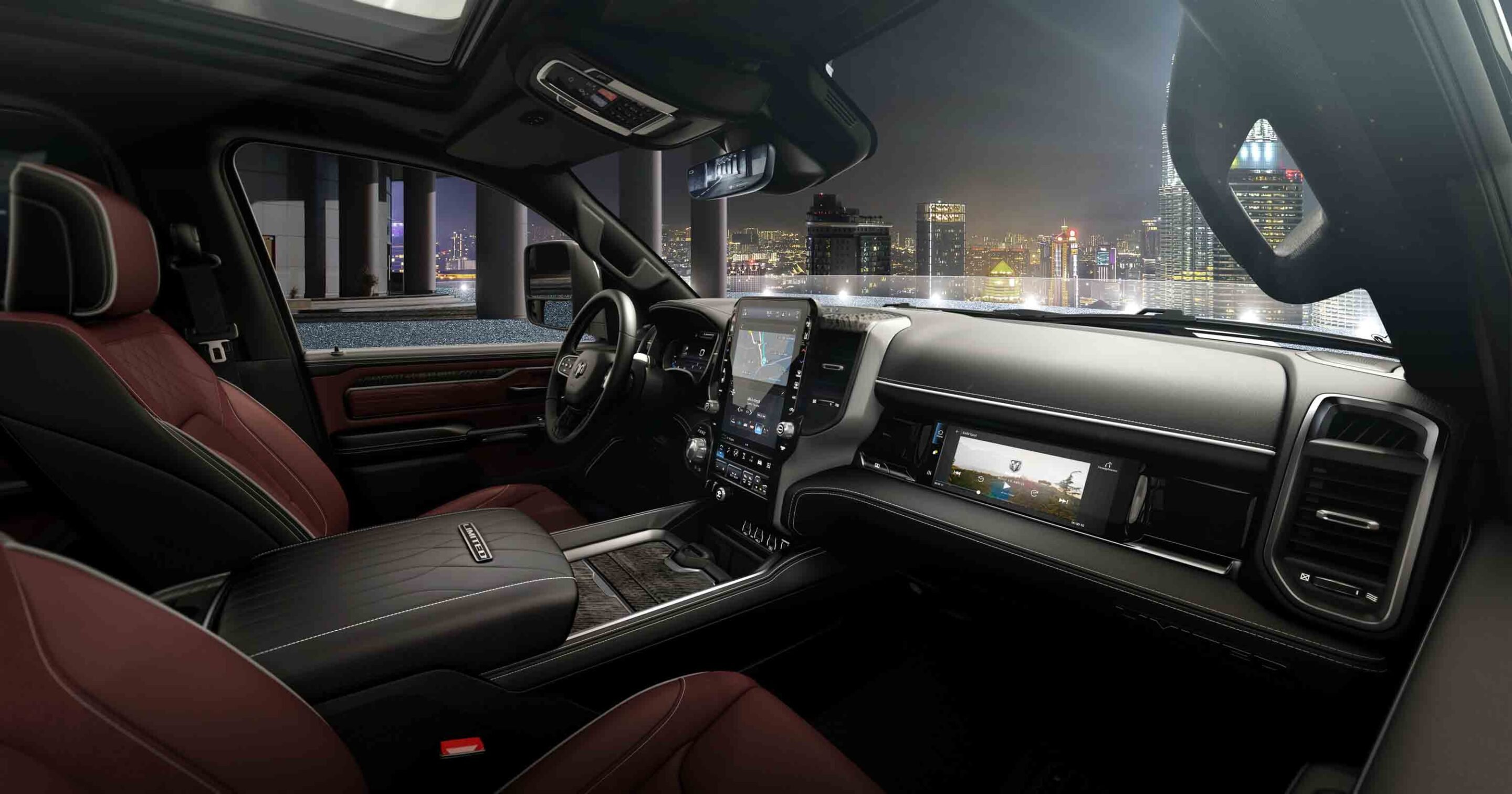
The 1500 REV combines a 3.6-litre Pentastar V6 generator with a 92kWh underfloor battery, powering electric motors at both axles. Total output is 487kW and 834Nm, with a claimed 0-60 mph (0-97 km/h) time of 4.0 seconds. Towing capacity is rated at 6350kg and payload at 1190kg. It also supports DC fast-charging up to 145kW and includes a 7.2kW onboard power panel for tools or camping gear.
“This vehicle will set a new benchmark in the half-ton segment, offering exceptional range, towing capability and payload performance,” Ram said. The 1500 REV targets a combined range of 1110 km and is listed as a 2026 model, with a launch date yet to be confirmed.
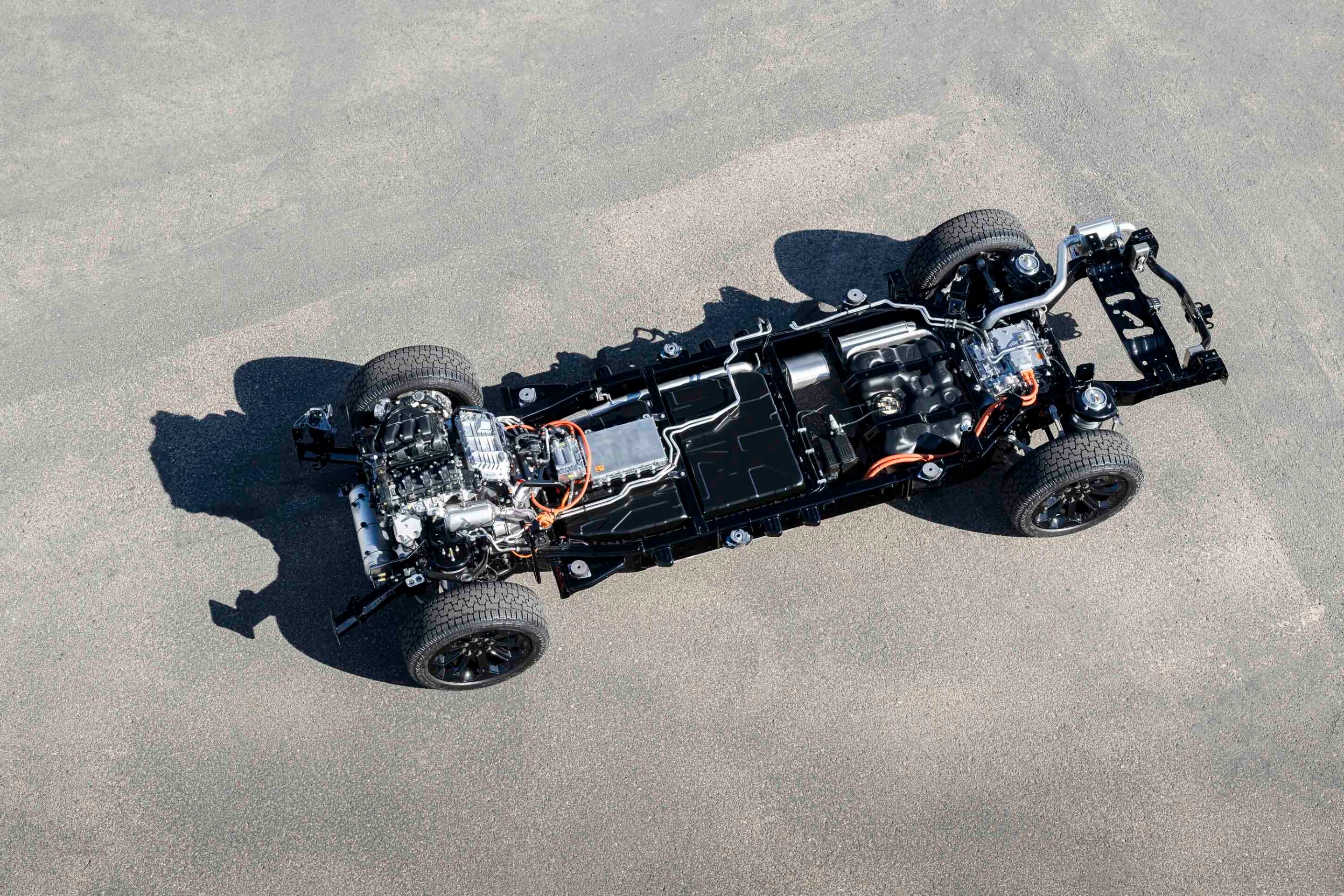
Ram recently added the off-road-focused 1500 Rebel to its Australian line-up in September, priced from $141,950 plus on-road costs.
The MY25 Australian-spec model is well equipped with the new 313kW/635Nm 3.0-litre twin-turbo Hurricane six-cylinder petrol engine, Bilstein off-road suspension with a one-inch lift, Falken Wildpeak 32-inch all-terrain tyres, underbody skid plates and an electronic locking rear differential.
Ford has recalled 1643 examples of its 2024-2025 Ranger after a software fault was identified that could reduce braking performance.
The issue affects all variants within this model range and stems from the brake boost function, which may not operate as intended. If the problem occurs, drivers may need to apply greater pedal force, and stopping distances could increase significantly, particularly when towing, carrying heavy loads or driving on steep or uneven terrain.
Warning lights for the ABS, ESC and brake system will illuminate on the dash, along with an audible alert, if the fault is active. Drivers are urged to take these warnings seriously, as ignoring them could have serious safety implications.
The official recall report can be found HERE
Reduced braking performance poses a clear safety risk, with a higher chance of collision. For the 4×4 community, the risk is even greater when vehicles are loaded with gear, towing trailers, or navigating off-road tracks where braking distances are more critical.
Ford Australia will contact affected owners and advise them to book their vehicle into a dealership. The fix involves a free software update to restore full braking performance – no other work is required. Owners are encouraged to arrange the update as soon as possible to ensure their Ranger remains safe both on and off the road.
This follows Ford Australia’s recall of its 2021 Everest last week, where a manufacturing defect meant the tow bar hitch may not have been welded to specification. In some cases, the hitch could detach while driving, creating a serious hazard for other road users.
In 1936, Ted Colson carved his name into outback history as the first European to cross the Simpson Desert.
With five camels, two months’ worth of supplies, and his Aboriginal companion, Eringa Peter, Colson left Bloods Creek on the desert’s western fringe and followed the 26th parallel to Birdsville. After a three-day rest, he turned around and made the 900km return trip in just 36 days.
Colson’s pioneering feat barely registered at the time, lost in the noise of a rapidly modernising world. But among four-wheel drivers, his legacy lives on in the Colson Track – a little-known but uniquely rewarding route that cuts deep into the heart of the desert.
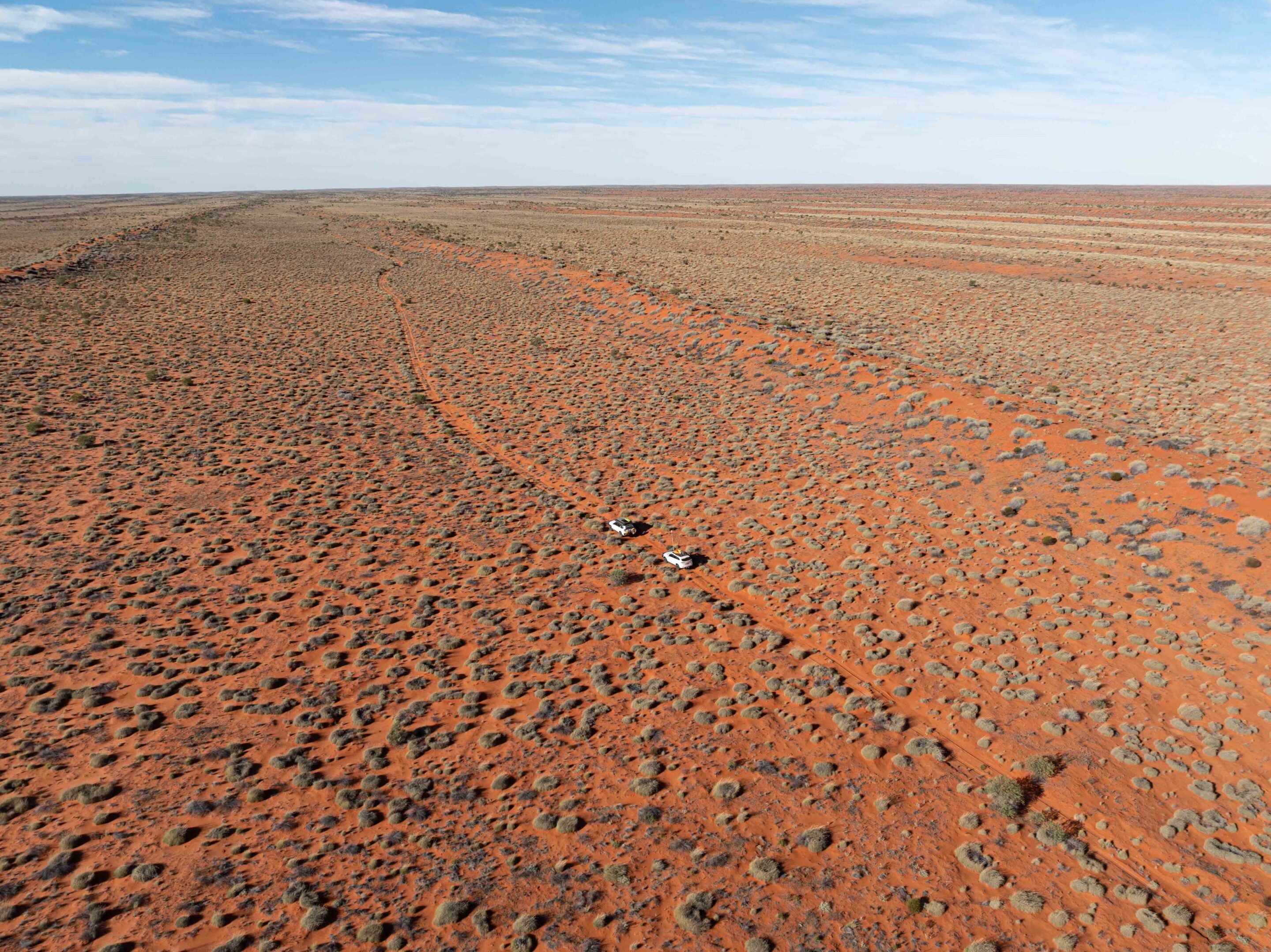
Starting the Colson Track at Old Andado Station
We kicked off the trip from Old Andado Station. Once home to outback icon Molly Clark, the homestead has been preserved like a time capsule.
A wander through the rooms feels like stepping back into Molly’s life before she relocated to Alice Springs. The station features a fantastic campground with flushing toilets and hot showers – provided the water tank is full.
From Old Andado, we tracked 38km north before detouring into the Mac Clark Conservation Reserve, home to the rare Acacia Peuce. These ancient trees have been around since the dinosaur age, with some standing tall for over 700 years. Bush camping is allowed in the reserve, but there are no facilities, and fires are banned to protect the fragile environment.
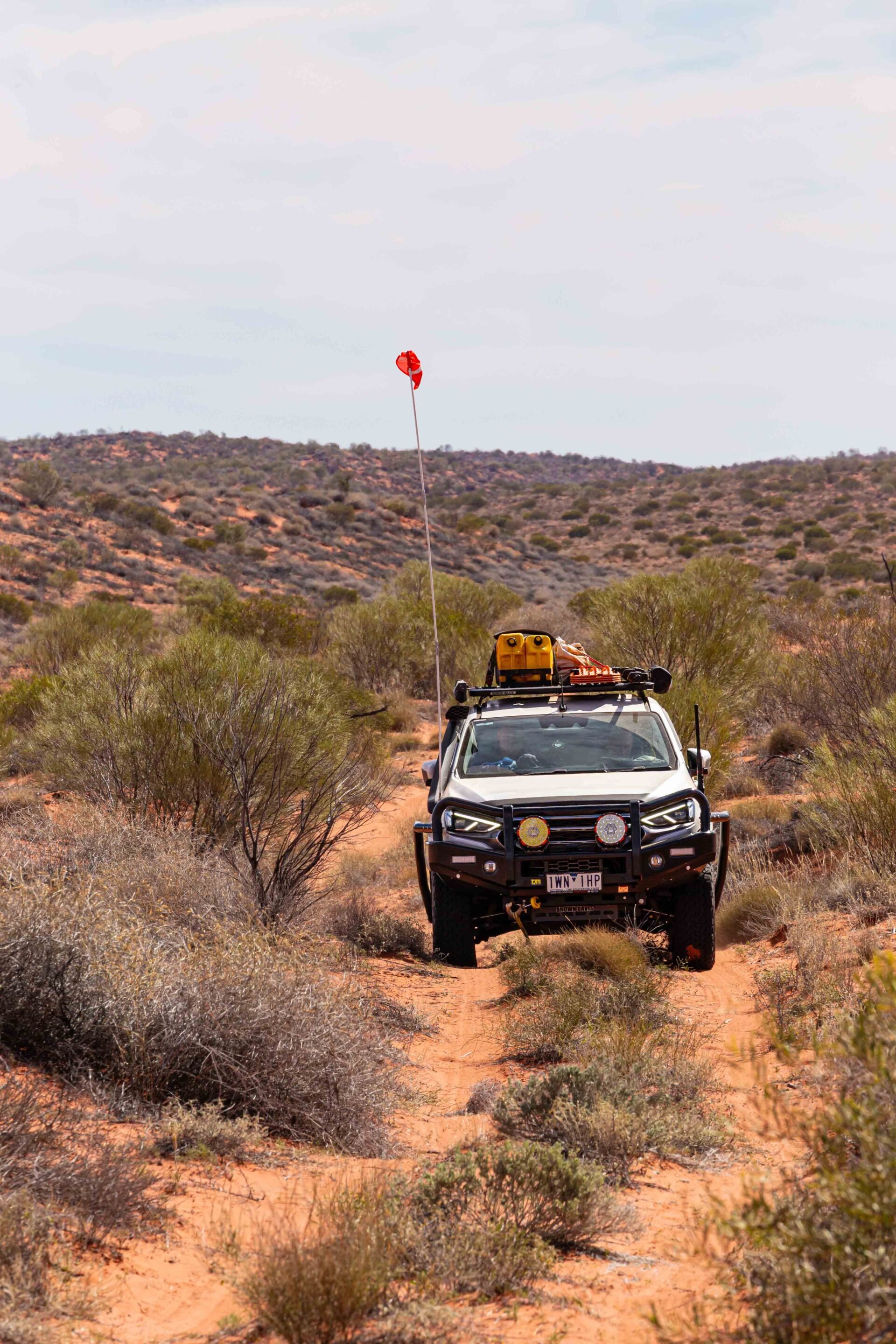
Driving the Madigan Line across the Simpson Desert
Backtracking from the reserve entrance, we turned east onto the Madigan Line. Named after explorer Cecil Madigan, the route follows the path of his 1939 scientific expedition – a camel trek across the Simpson Desert.
The track was heavily corrugated and broken up by countless water diversion humps. After passing Casuarina Swamp and the windmill at East Bore, we hit dune country. Out here, cattle turned up in unexpected places along the rough trail – something to keep an eye out for.
We soon pulled into Madigan Camp 1A. A short track heads west over a dune to Madigan Camp 1, but access is restricted – permits don’t allow travel to Camps 1-4. After grabbing the obligatory camp sign photo, we pushed on towards Marshall Bluff.
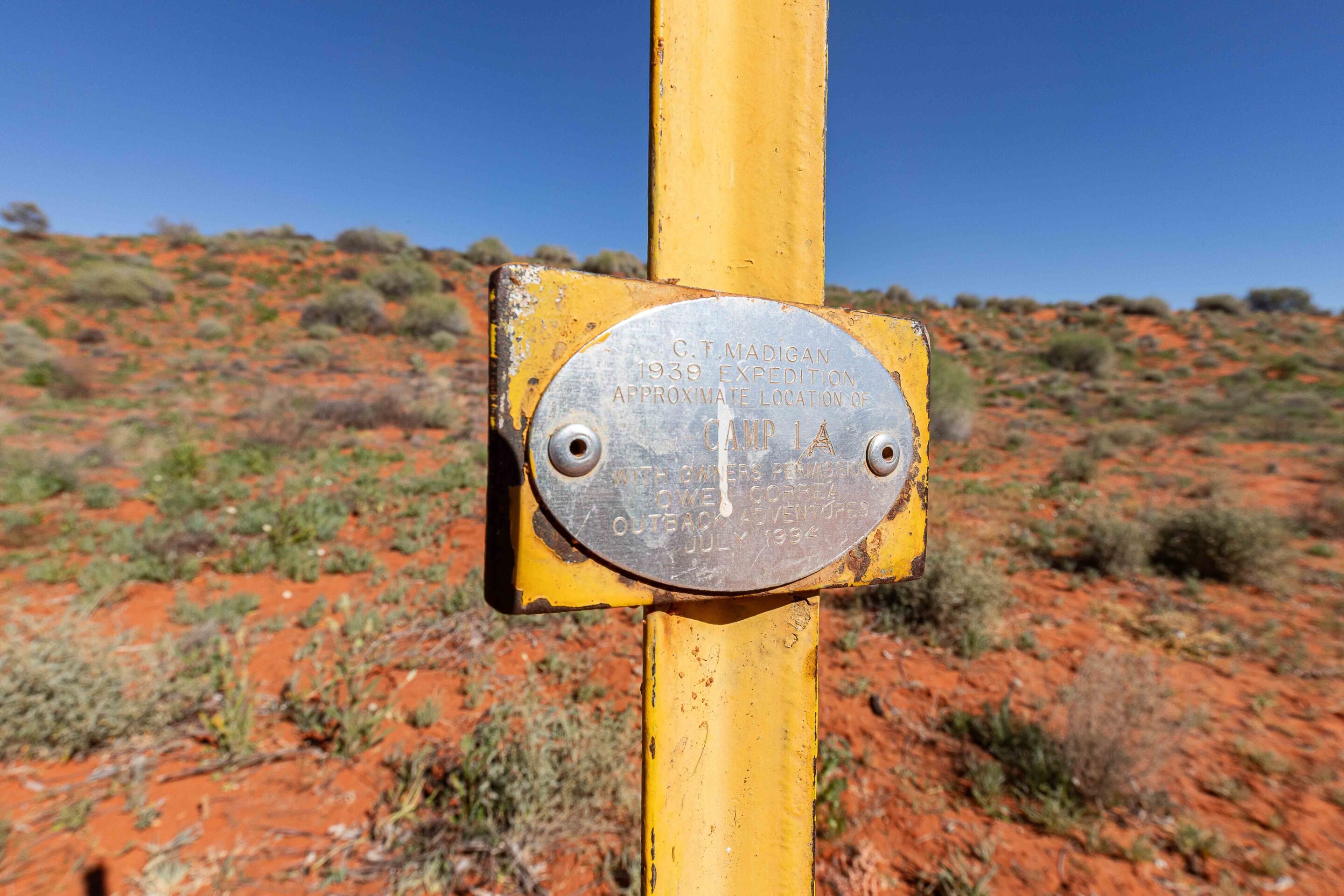
Tackling Marshall Bluff on the way to the Colson Track
Marshall Bluff is a rugged section of the landscape, characterised by its stony outcrops that jut out dramatically against the sky, creating a striking contrast with the golden sand dunes dotted throughout the area.
As we navigated this challenging terrain, the track narrowed, and the rocky surfaces demanded our full attention and careful manoeuvring. Despite the difficulties, the views were nothing short of breathtaking, offering a vivid snapshot of the ever-changing terrain that unfolded around us, showcasing nature’s diverse beauty.
As we made our way back to the plains, the road transitioned once again into a sandy surface, something we had grown accustomed to during our journey. However, the familiar corrugations reappeared, rattling our vehicles as we approached Madigan Camp 5, which is strategically located at the junction with the Colson Track. Here, we decided to stop for a quick lunch, taking a moment to gather our thoughts and energy while contemplating the adventure that lay ahead. Would the Colson Track be reminiscent of the rugged Hay River Track, or would it offer unexpected surprises and challenges?
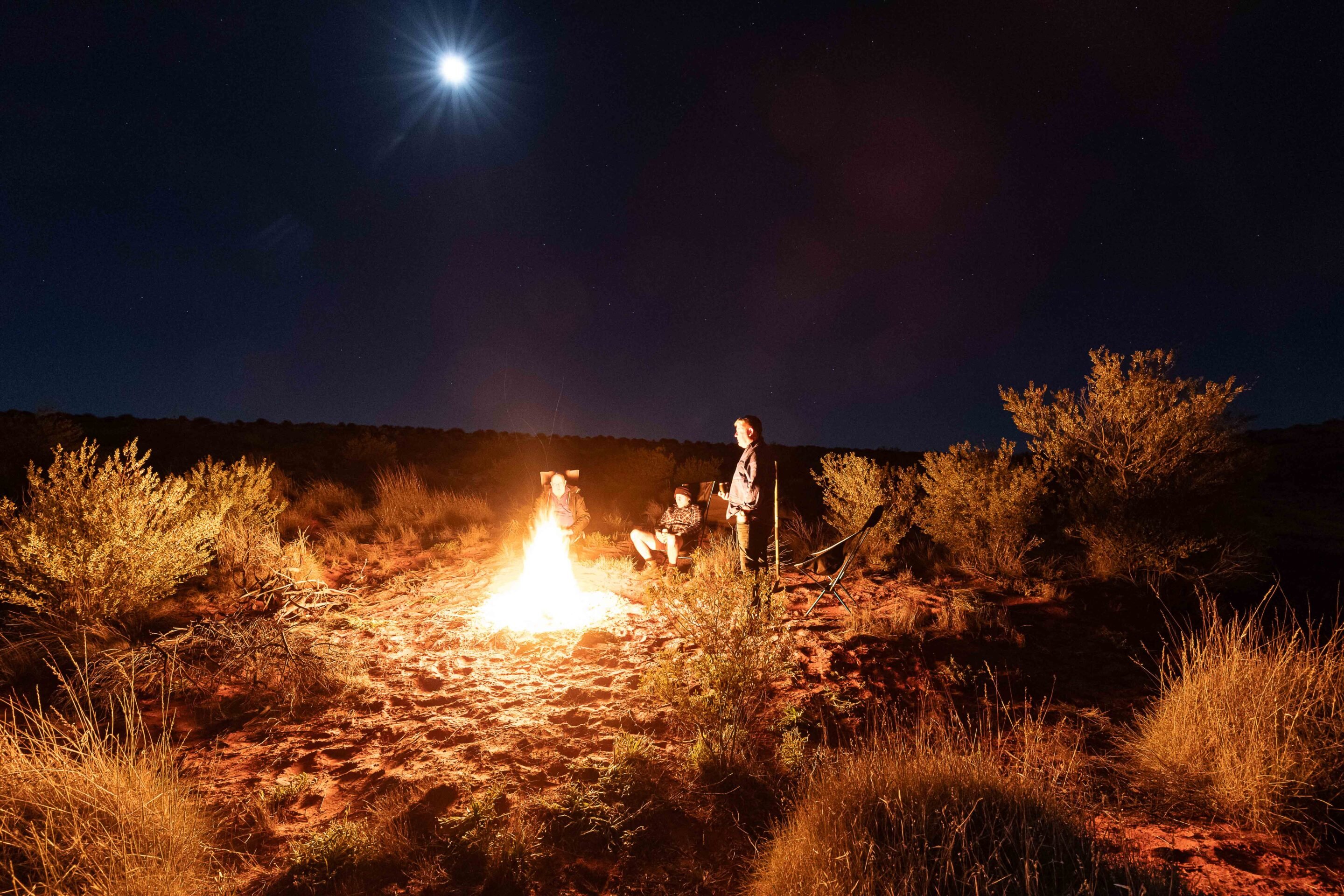
Heading south on the remote Colson Track
Turning south onto the Colson Track, we immediately sensed a change in atmosphere.
This route, less-travelled and often overlooked, winds its way through the swale nestled between the towering north-south red sand dunes, creating a sense of seclusion and adventure. The terrain was varied, comprising expansive gibber flats that reflected the stark beauty of the outback, claypans that glistened under the sun, and the ever-present spinifex that dominated the landscape with its resilient green hues and sharp blades.
As we ventured further south, the feeling of remoteness intensified. The midsection of the track offered few clearings, and without any designated campgrounds available, we found ourselves pitching our swags right on the track itself. We ensured that we did not disturb the delicate balance of nature around us, mindful of the fragile dunes and the surrounding vegetation that our presence could easily harm.
Dinner that night was simple but satisfying – hot pies out of the Travel Buddy. The flies were relentless, hanging around well after sunset, but the warmth of the fire made up for it. We sat around the flames swapping stories and laughs, soaking in a moment that would stick with us long after the coals went cold.
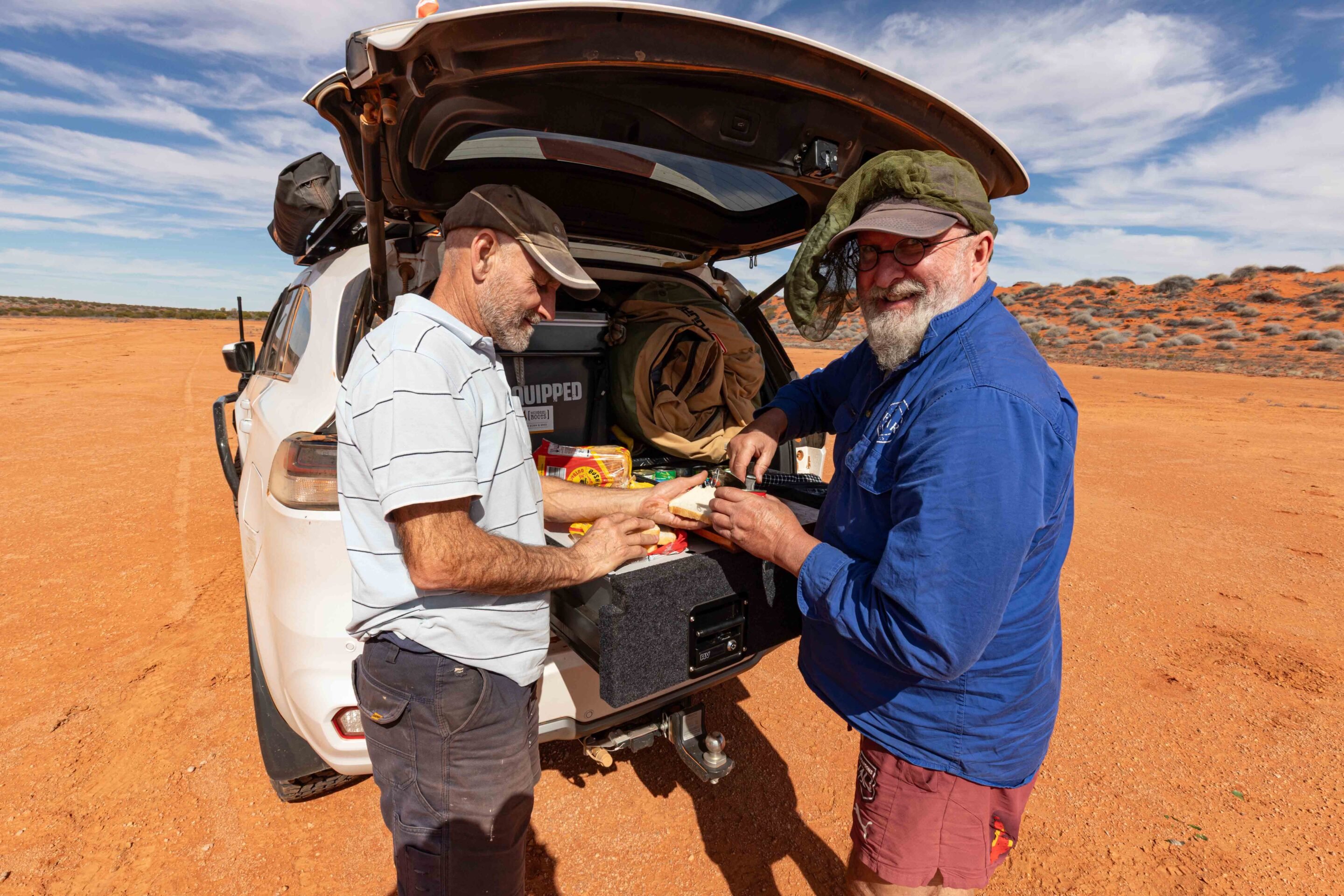
Sunrise on the Colson Track and Outback wildlife encounters
Day two kicked off with a blazing sunrise that lit the sky in orange and pink – a classic outback wake-up call. It was a brisk 5°C, so that first coffee hit the spot. By 7:30am we were back on the track, keen to see what the desert would throw at us next.
The desert was dead quiet – the only sound was the steady crunch of tyres on soft sand. Every now and then we’d spot the faint tracks of dingos or camels that had passed through earlier, a subtle reminder we weren’t alone out here.
This stretch of the Colson Track was a welcome surprise – smooth and easygoing, a rarity out here. With so little traffic, the track was in great nick. No corrugations, no drama – just a winding path through wide fields of old spinifex and scattered desert scrub, showing off the raw beauty of the landscape.
Wildlife was scarce, but we did spot the odd lizard darting across the sand, quick to vanish as we rumbled past. I kept an eye out for the elusive thorny devil, but luck wasn’t with us this time. Still, the day rolled on, and with it came the promise of more surprises in the sand.
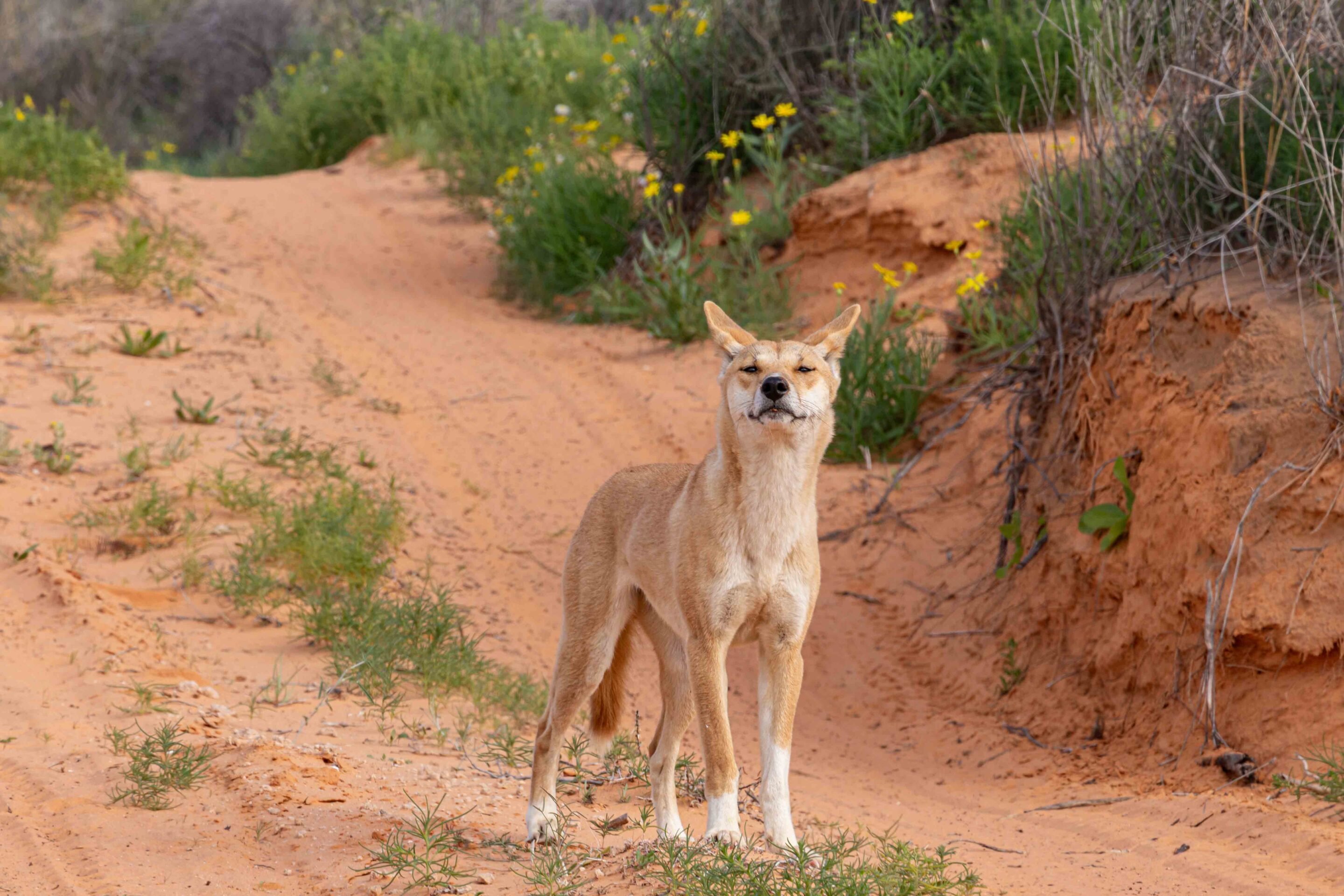
Crossing spinifex country on the Colson Track
Progress slowed as thick spinifex and hidden root balls filled the ruts, making for a rough and unpredictable ride.
The track rose and dipped with the land, opening up at times to wide claypans and gibber plains stretching to the horizon. These brief changes let us nudge the pace up – but only when the terrain allowed, and always with an eye out for what might come next.
Along the way, we came across a rusted old trailer abandoned beside the track – a curious relic, maybe from an old mining operation or a long-forgotten army expedition. Finds like this spark the imagination and serve as reminders that the desert holds layers of human history, scattered and fading into the sand.
After about four tough hours on the track, the swale opened up, offering more space and better camping options. Around 30km north of the French Line, we rolled onto a wide claypan that felt like a natural lunch stop – a welcome break from the constant pitching and yawing behind the wheel. We stretched our legs, soaked in the stillness, and took a moment to appreciate the sheer scale of the desert stretching out ahead.
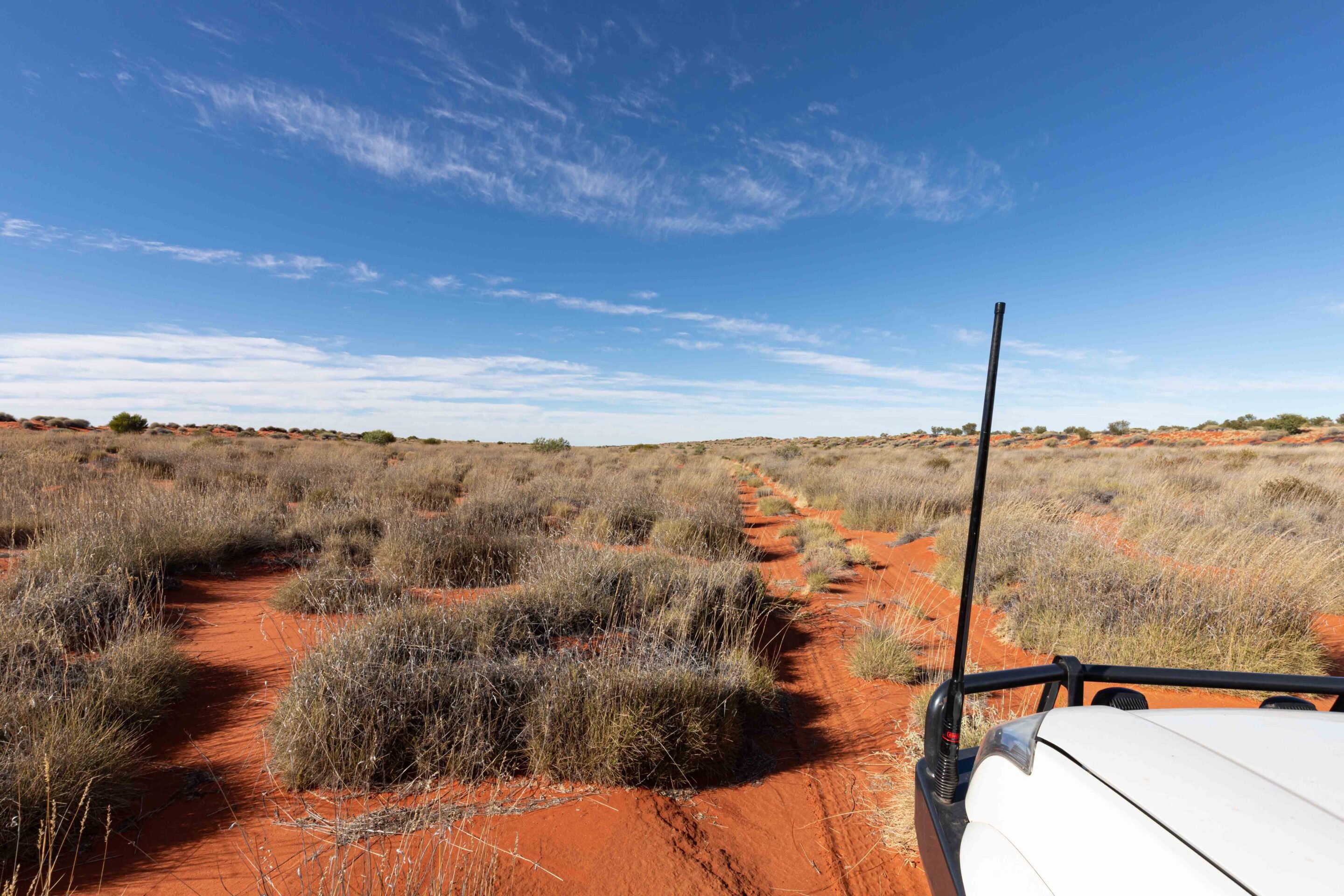
Colson Track to French Line: Simpson Desert connection
Back on the track, we passed through a grove of old gidgee trees just north of the historic Colson Oil Well.
One tree held a large, empty nest – likely built by a hawk or wedge-tailed eagle, both impressive birds native to this region. Not long after, a healthy-looking dingo trotted along the track ahead. It was a striking sight – lean, alert, and moving with purpose – but it vanished before I could grab a photo.
Crossing from the Northern Territory into South Australia was a non-event – no signposts, just the arrow on the Hema HX2 confirming we’d entered a new state. About 23km later, we hit the junction with the French Line – one of the Simpson’s most iconic crossings. We considered setting up camp in the nearby Gidgee trees, but it was still early. Spirits high, we pushed on, keen to see what else the track had in store.
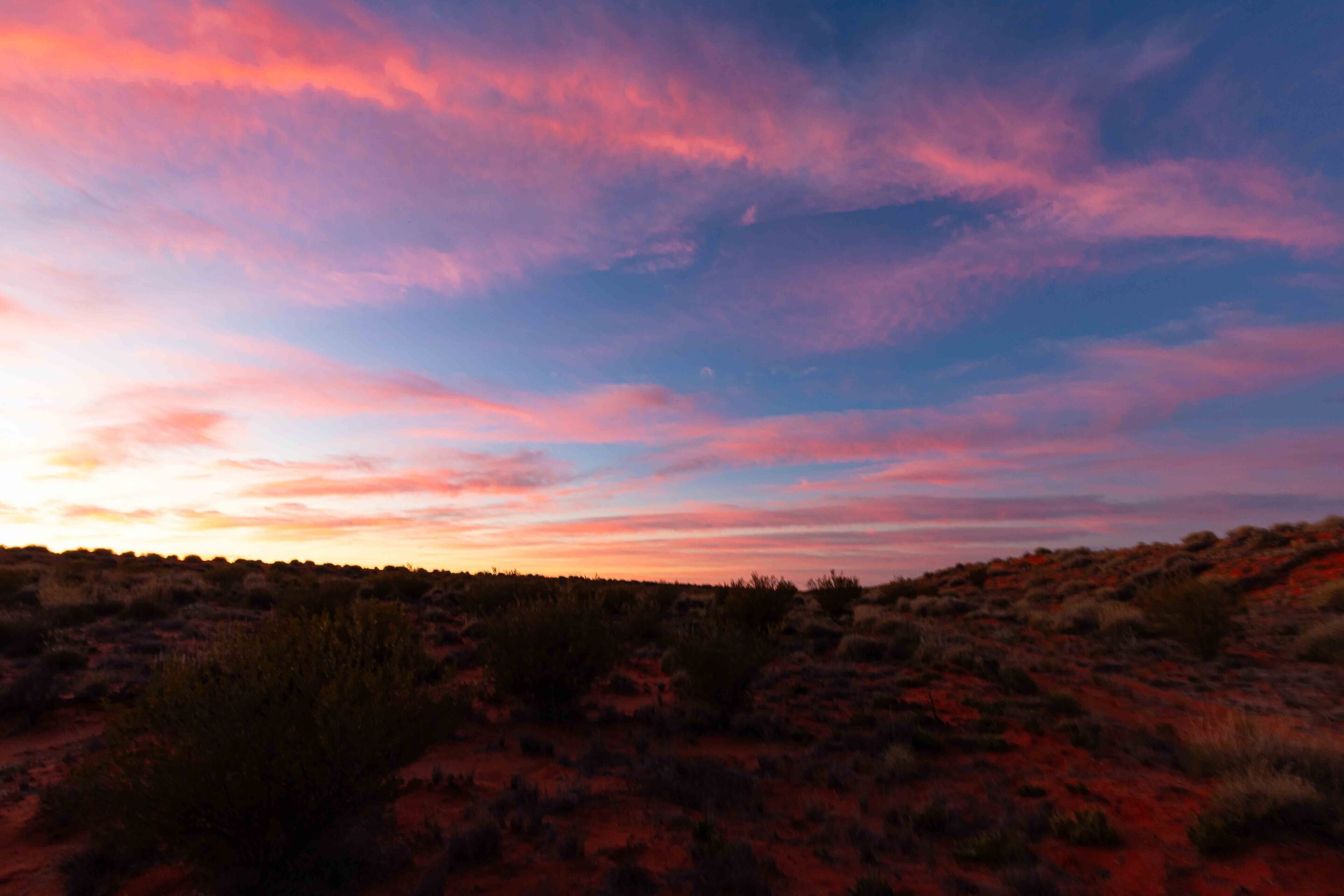
Camels on the Colson Track and reaching the WAA Line
Just when we thought the surprises were finished, three camels appeared in front of us, creating an unexpected yet amusing obstacle.
Two of the camels peeled off quickly, but the third chose to run straight down the track. For nearly 10km, we trailed behind our new companion, its gangly legs moving rhythmically in a comical bounce as it trotted ahead of us. Finally, after what felt like an eternity, it veered off to the side, allowing us to accelerate and regain our momentum. With renewed energy, we pressed forward to reach the end of the Colson Track at its junction with the WAA Line.
Just 19km from the French Line, we pushed on along the Rig Road. As dusk closed in, we made camp on a scenic dune near the famous Lone Gum. It had been a day full of surprises, and as we sat under the stars swapping stories and laughs, we were reminded of just how unpredictable – and rewarding – desert travel can be.
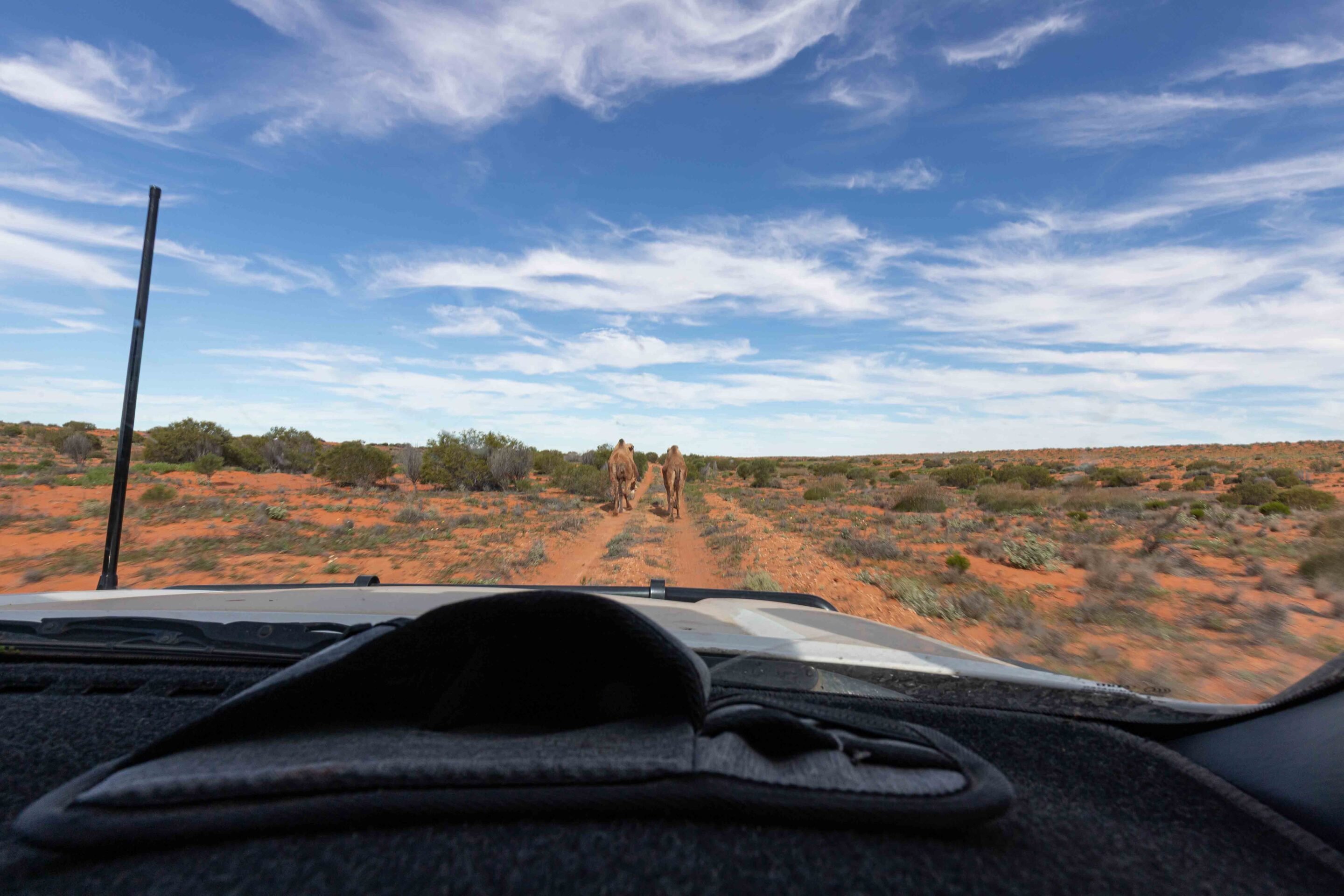
History of the Colson Track and Ted Colson’s legacy
Most assume the Colson Track was named after explorer Ted Colson, but there’s a strong case it was actually named after the nearby Colson Oil Well.
The well was drilled close to where Colson passed during his 1936 expedition across the desert near the 26th parallel – the border between Queensland and South Australia. Whatever its true origin, the Colson Track is a fitting tribute to a bold explorer. It calls to today’s adventurers, offering a one-of-a-kind journey through the mesmerising heart of the Simpson Desert.
This vast and arid region showcases not only stunning natural beauty but also the legacy of those who dared to explore its uncharted territories. Each step along the Colson Track allows travellers to appreciate both the history of exploration and the arid landscape that defines this part of Australia.
In that sense, the Colson Track is more than just a line on the map – it’s a living tribute to the grit and determination of explorers like Ted Colson, inviting all who follow it to embrace the spirit of adventure and discovery that defines the outback.
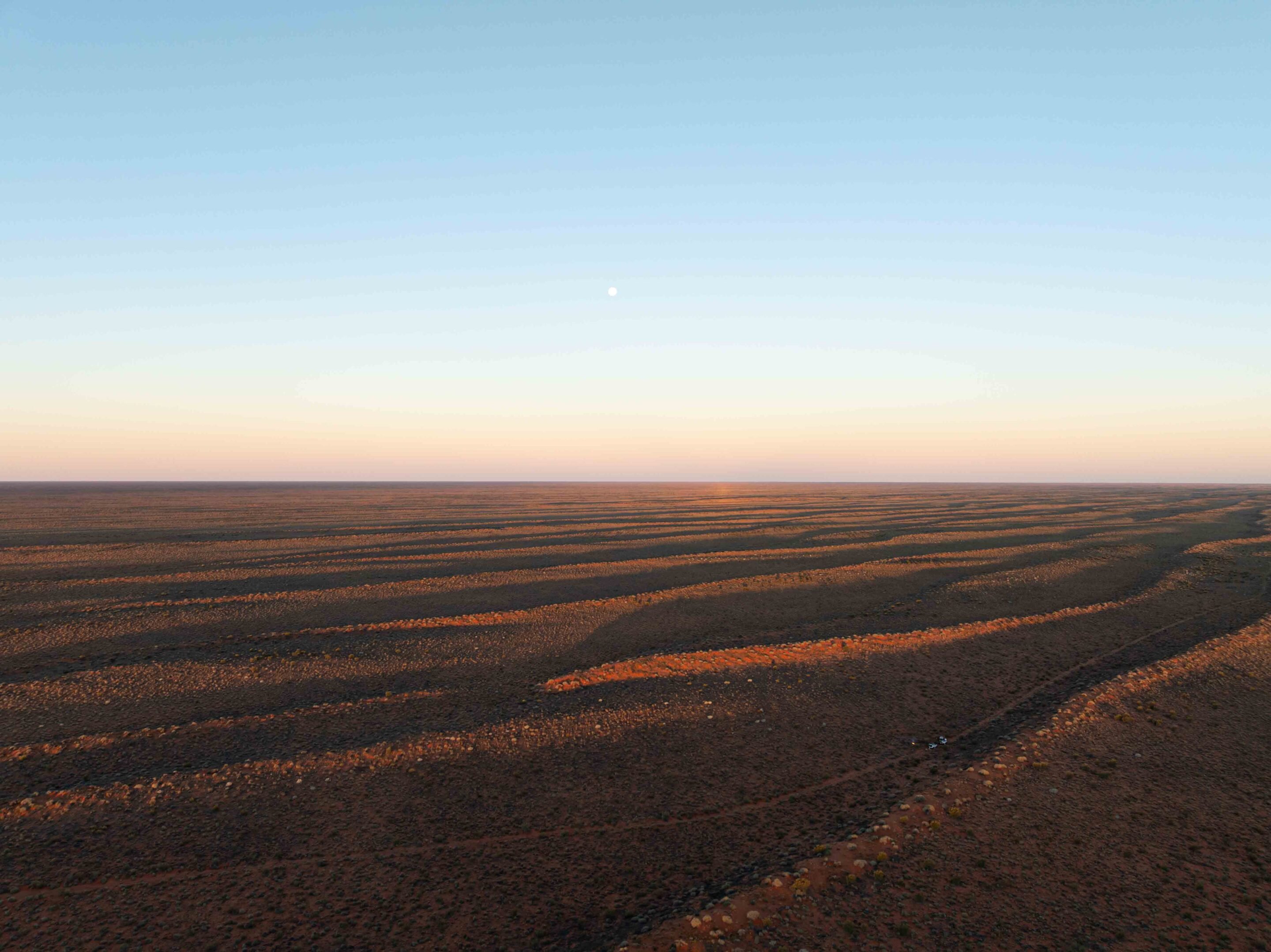
Why drive the Colson Track in the Simpson Desert
The Colson Track offers a unique perspective on the Simpson Desert that few travellers have the opportunity to experience.
Characterised by its profound isolation, tranquillity – and absence of commercial traffic – this track is ideal for those who are yearning for an authentic desert adventure. It’s not merely about checking off the famous dunes or reaching well-known campsites, but instead immersing oneself in the vastness and stillness of this ancient land.
The colours alone are reason enough to go – vivid orange dunes set against deep cobalt skies, broken by patches of bright green spinifex. It’s a natural masterpiece. While some stretches of the track may feel repetitive, the real reward lies in the experience. Out here, solitude invites reflection, the landscape reveals its quiet beauty slowly, and there’s a deep satisfaction in following the tracks of those who came before – a connection to the desert’s rich, enduring story.
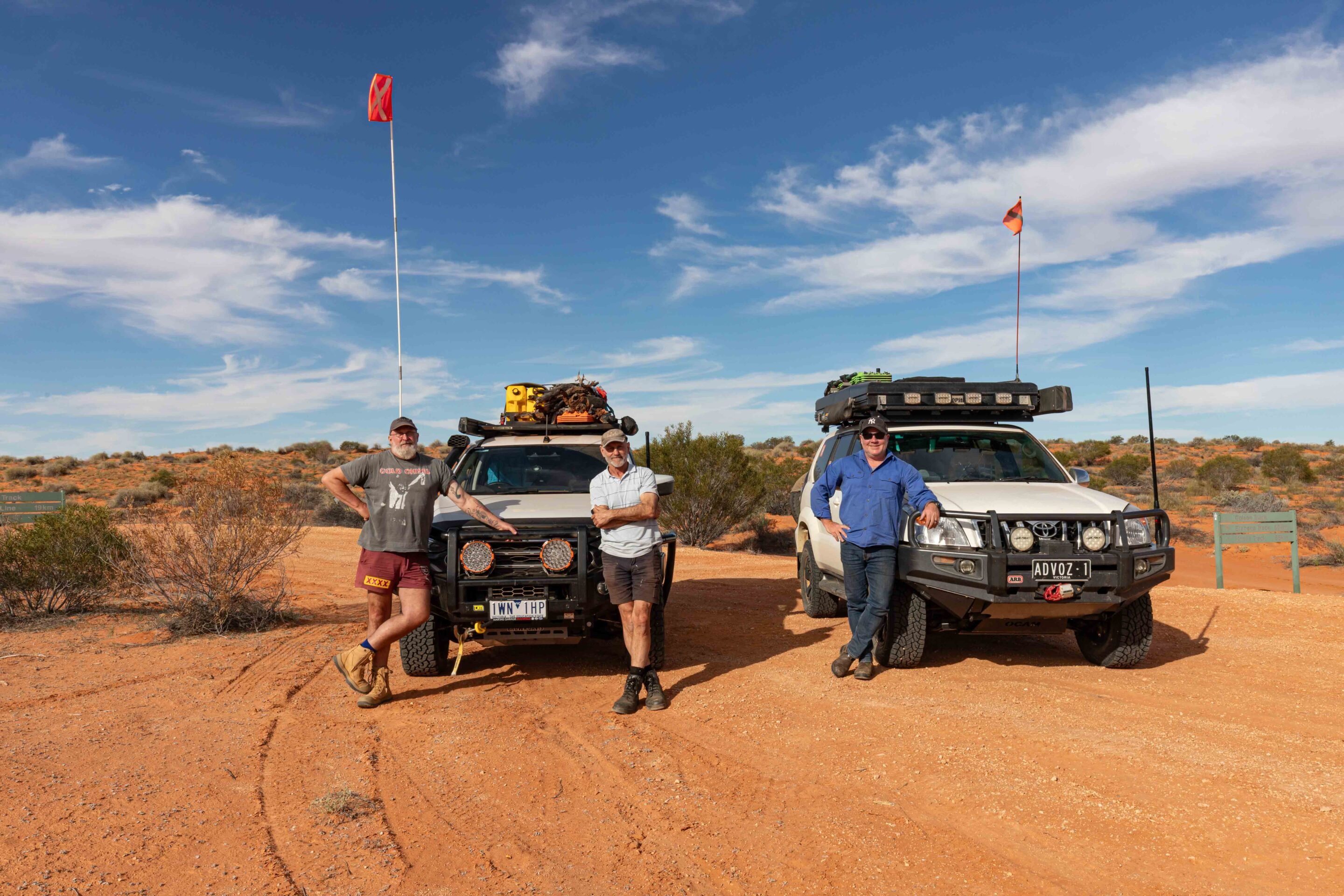
Whether you’re chasing the story of Ted Colson or just looking for a lesser-travelled route through the Simpson, the Colson Track delivers a true outback adventure. It demands patience, preparation and a healthy dose of curiosity – but what you get in return is pure desert magic.
Add the Colson Track to your bucket list if you’re after something different to the well-worn French Line or QAA. This isn’t just a route – it’s a journey where the destination is a deeper connection to country, and to the legacy of those who first dared to cross it.
Essential travel info
- Starting point: Old Andado Station, NT
- End point: Rig Road, SA
- Distance covered: 450km
- Duration: 2–3 days recommended
- Best time to go: April to September
- Track rating: Easy
Permits required
- NT Parks Pass – Mac Clark Conservation Reserve: nt.gov.au/parks/parks-pass
- SA Desert Parks Pass: parks.sa.gov.au/book-and-pay/desert-parks-pass
- •Central Land Council Permit – Madigan Line & Colson Track: clc.org.au
Recommended gear
- Long-range fuel tanks (no fuel for hundreds of km)
- Satellite phone or HF radio
- Sand flag
- Air compressor and recovery gear
- Detailed maps (Hema HX2 or paper backup)
- Minimum two vehicles (travel in convoy)
- Firewood and all water/supplies – no facilities along the route
No matter how many new vehicles hit the market, we’re always chasing something different – something built for us and no one else. A rig that stands apart from the crowd, tailored to our needs, not the showroom spec.
Toyota’s 4×4 range is one of the biggest around – surely there’s something for everyone? Not for Graeme. He wanted something different: the comfort of a wagon, the practicality of a ute, and the classic cool of a vintage 80 Series. Oh, and it had to have a V8 – not just any V8, but the twin-turbo diesel from the 200 Series LandCruiser.
Graeme is a farmer in regional Victoria and like most make their living off the land in Australia, he is no stranger to Toyota. There’s always a HiLux or two in the shed or running around the paddocks, and his current fleet also includes a pair of 40th Anniversary 80 Series and a couple of 79 Series workhorses.
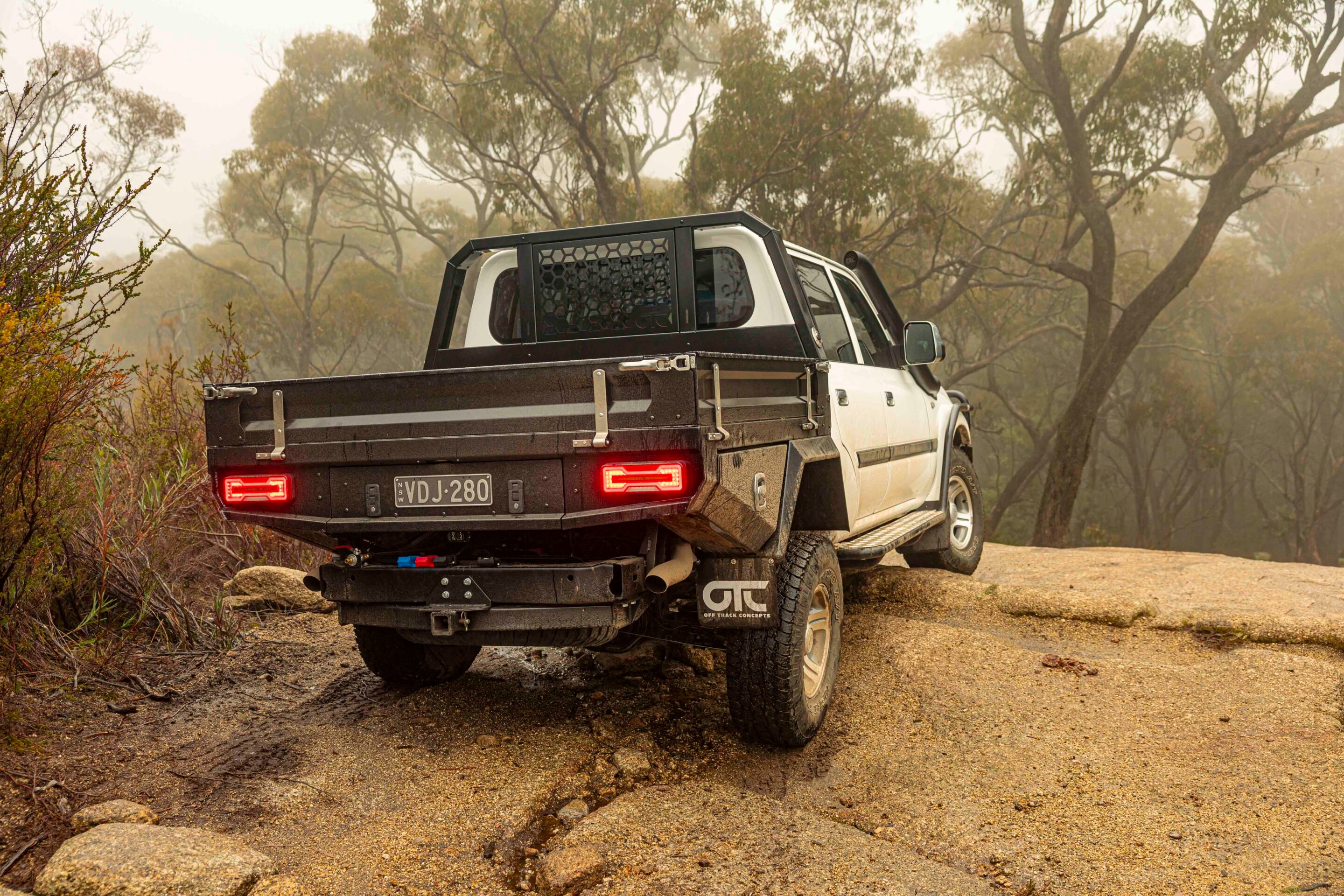
The 79 Series LandCruiser was too agricultural for the build Graeme had in mind, and the HiLux too small. So he went looking for someone who could bring his vision to life.
Enter Off Track Concepts (OTC) in Cobram, Victoria. Hagen Skinner and the team at OTC have been dropping 1VD V8s into 80 and 100 Series LandCruisers for years, and one of their earlier builds even featured in these pages back in 2024.
“From the first time I contacted Hagen and said that I wanted a chopped 80 with extended chassis and a V8, he just said yes, he could do all that,” recalls Graeme.
The plan was to use one of the anniversary models that Graeme already had but then another one came up that had a better body, ARB bull bar and roof rack, but a dodgy transfer case. And yes, it’s another 1997 40th Anniversary 80 Series.
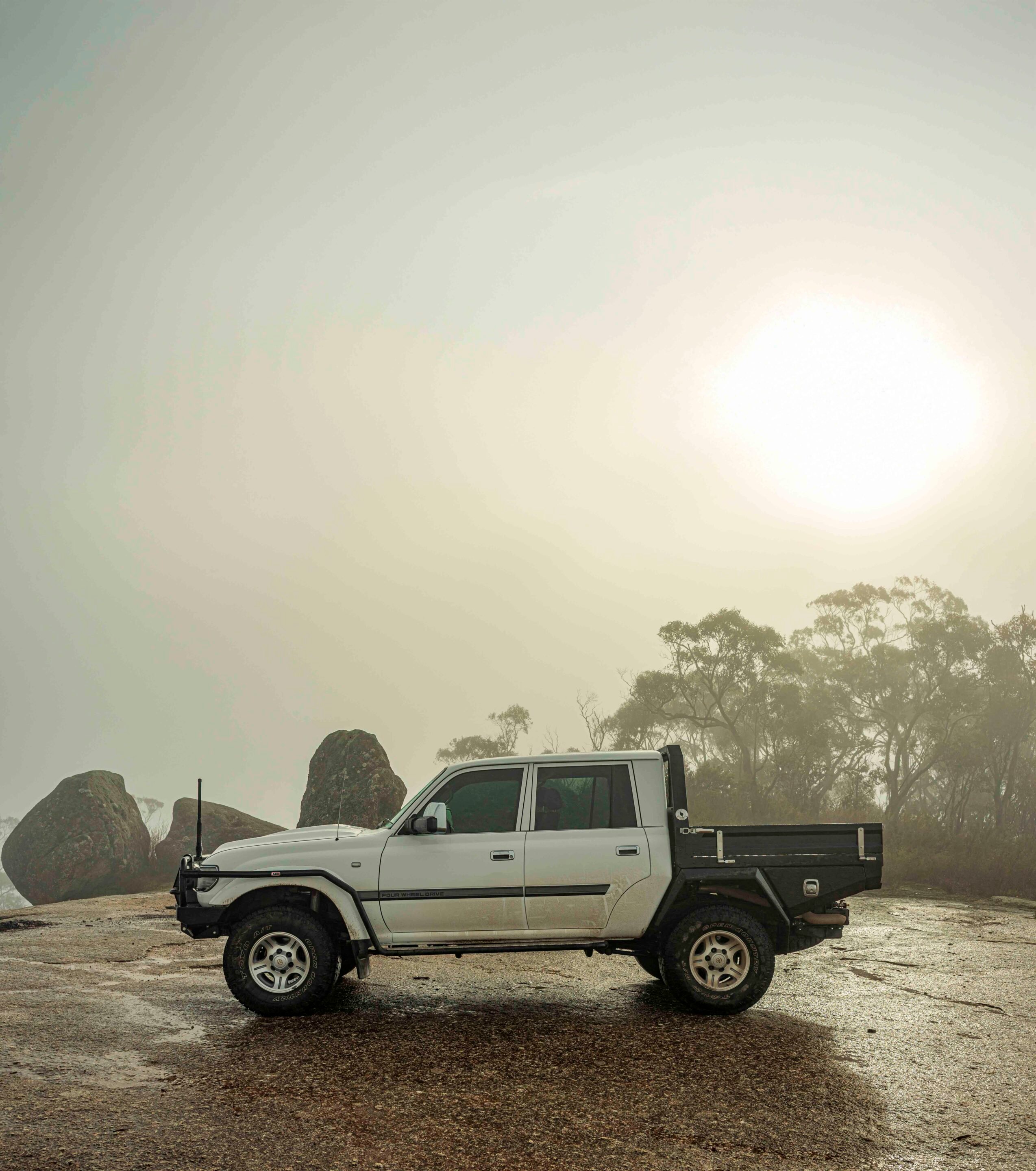
Chassis strip and VDJ engine conversion
As you’d expect from a build that involves an engine swap and stretched wheelbase, the first step was stripping the LandCruiser back to a bare chassis.
Once that was done, it was time to blast away 28 years of built-up grime before breaking out the cutting tools. The rear of the chassis was lopped off just ahead of the suspension arm mounts, allowing OTC to retain the factory Toyota geometry when the section was reattached 300mm further back. Up front, custom engine mounts were fabricated to house the Toyota V8, and the known weak point around the steering box was reinforced before the entire chassis was finished in two-pack black.
While a donor 200 Series supplied many of the parts for the conversion, its engine was already cooked. So the team sourced a brand-new 1VD from Toyota, along with a new six-speed auto and a 79 Series transfer case. The engine is actually a 79 Series–spec single-turbo unit, chosen because it comes with the correct sump to fit neatly into the 80 Series chassis.
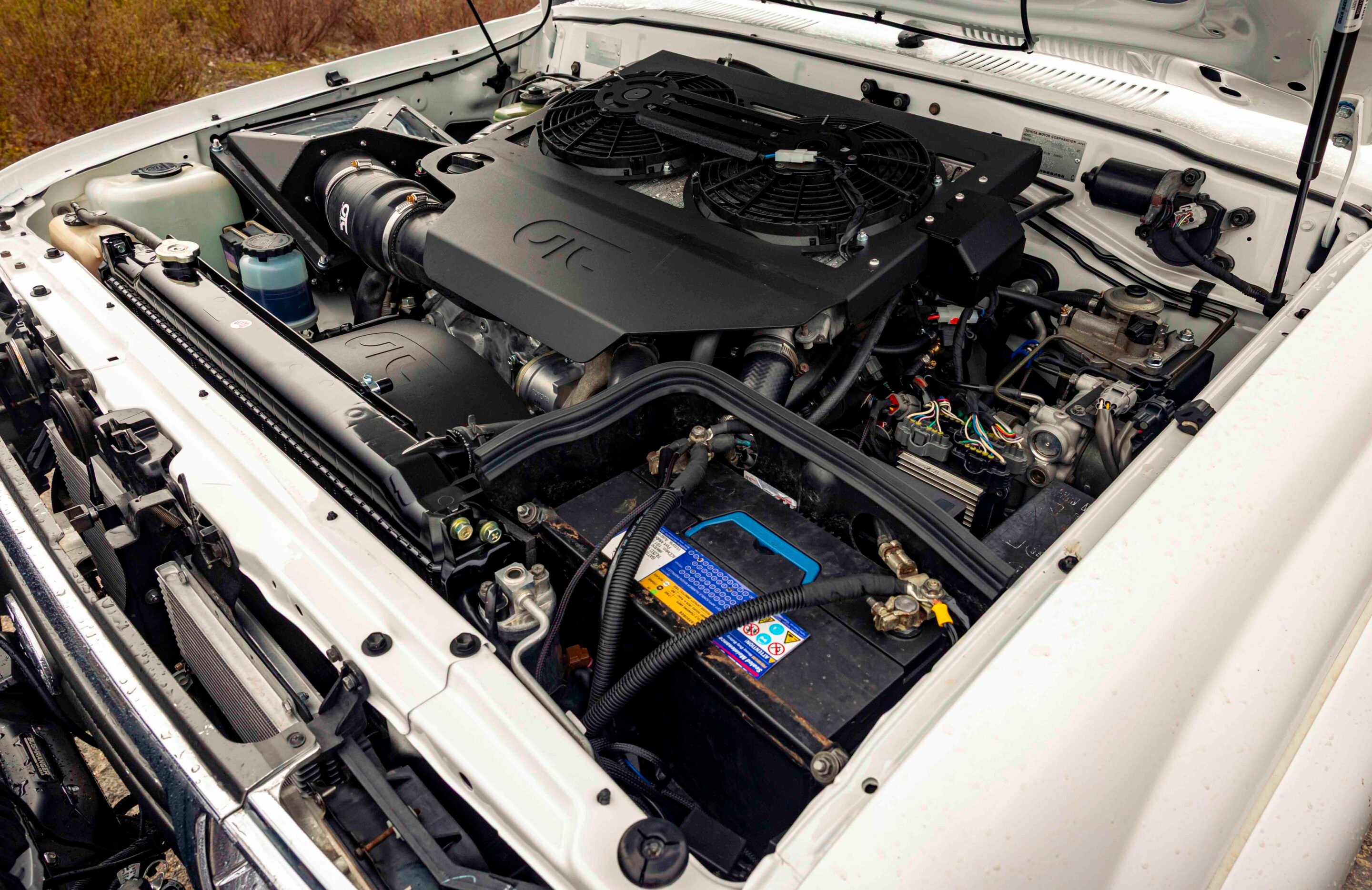
A pair of G Turbo Green Wheel turbos were bolted on, supported by a mix of 200 Series and custom-fabricated piping and ancillaries to make everything fit in the 90s-era engine bay. A set of +90 injectors and a custom ECU remap had the 1VD running sweet, and on the dyno it laid down an impressive 1000Nm and 245kW at the tyres.
The engine breathes through an OTC-fabricated airbox and snorkel, while Hagen also custom-built the dual three-inch stainless-steel exhaust. His handiwork continues with the shroud and twin fans mounted to the PWR intercooler.
As expected, the 200 Series six-speed auto bolts straight up to the 1VD. At the other end, a Wholesale Automatics adapter mates the transmission to the 79 Series transfer case without fuss. The 80 Series diffs have been refurbished with new bearings seals and hardware including ARB Air Lockers front and rear.
Custom trayback and body modifications
Before the classic 80 Series body could be reunited with its stretched, repowered chassis, the rear section was chopped off behind the back doors. A custom one-piece panel and rear window were fabricated and fitted, sealing it up as a double-cab ute.
Aside from the chopped rear, the only other departure from Toyota’s classic lines is the bonnet. OTC worked its magic here too, grafting the 79 Series bonnet bulge and scoop onto the 80 Series skin to feed the intercooler. It’s a work of art and it looks factory. About the only thing Hagen and the OTC crew didn’t handle was the bodywork and paint. That was outsourced, with the panels tidied up and resprayed in factory white.
Back at the OTC workshop, the aluminium tray was completed and bolted on. Up front, the original ARB bullbar was modified to house a set of ARB Intensity lights, then refitted along with a Bushranger Covert winch and ARB side rails.
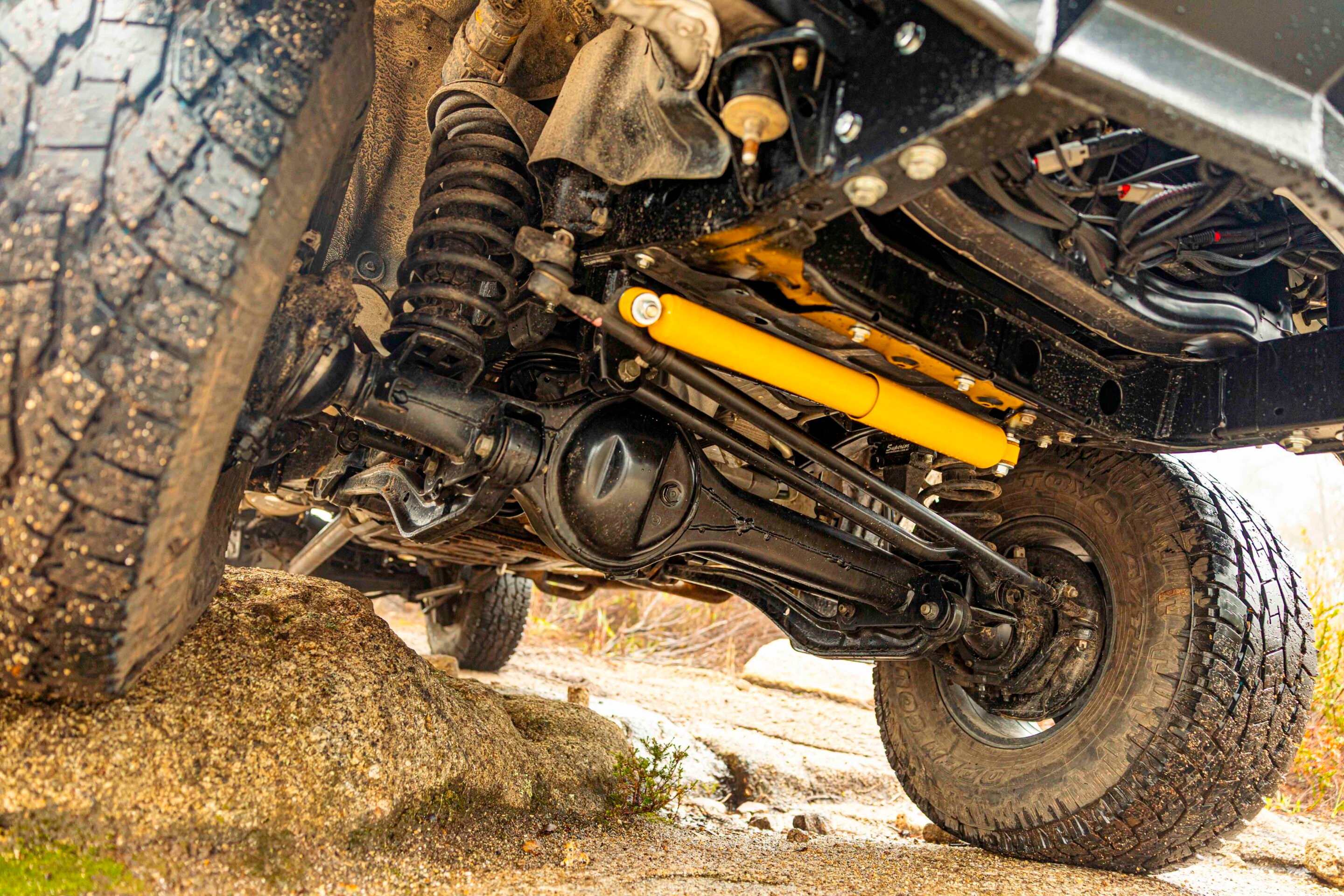
ARB was also the go-to for the suspension, with a full OME BP-51 setup fitted, along with a twin air compressor neatly mounted in one of the under-tray toolboxes. While the tray-back and modest tyre size suit work duties around Graeme’s property, the Cruiser will also see touring use, so an OTC canopy is on the way for the tray, along with an auxiliary fuel tank to extend the driving range.
Inside, the cabin has been upgraded for touring comfort and functionality. Recaro Specialist L seats hold the driver and front passenger in place, while a Sony head unit brings modern audio and sat-nav capability. A ScanGauge 3 sits in clear view to monitor engine vitals, and the cabin has been fully sound-deadened for a quieter ride.
OTC also built the custom centre console, which houses the 200 Series transmission’s gear shifter alongside the 70 Series transfer case lever. The part-time 4×4 system keeps things simple, even when backed by a thoroughly modern drivetrain. Just because the OEMs didn’t build your dream rig doesn’t mean it can’t exist. With a clear vision and the help of the skilled crew at Off Track Concepts, Graeme brought his dream LandCruiser to life.
It’s a seamless fusion of classic 80 Series charm, modern V8 muscle and the practicality of a tray-back setup ready for work or touring.
Ford Australia has issued a recall for 701 examples of the Everest built in 2021, citing a potential safety risk with the tow bar assembly.
According to the notice, a manufacturing defect means the tow bar hitch may not have been welded to specification. In some cases, this could cause the hitch to detach from the tow bar while driving.
Ford notes that if a caravan or trailer is correctly fitted with safety chains, it would remain attached to the vehicle even if the hitch detaches. The risk, however, is that a detached tow bar hitch could create a serious hazard for other road users or bystanders, increasing the chance of an accident, injury or death.
The official recall report can be found HERE
For 4×4 owners and touring enthusiasts, the defect is particularly relevant, as many Everests are used for towing heavy camper trailers, boats and caravans over long distances. A compromised tow bar could pose added risks on highways or remote-area tracks, where recovery options are limited and any incident could lead to delays, vehicle damage or injury. It is therefore critical that affected vehicles are inspected and repaired before undertaking extended towing trips.
Ford will contact owners of the affected vehicles directly. Impacted customers are advised to make an appointment with their local Ford dealership, where the tow bar assembly will be inspected and rectified free of charge.
More information about the recall is available through Ford Australia or via the ACCC’s Product Safety website. Touring drivers are reminded to always check towing equipment, including safety chains and hitch connections, before heading off on long trips or off-road adventures.
Foton has launched its first ute dealer network in Australia and opened pre-orders for the Tunland, a diesel-hybrid dual cab priced from $39,990.
The range includes two models, the V7 and V9, both powered by a 2.0-litre turbo-diesel paired with 48V mild-hybrid tech and an eight-speed ZF automatic. Buyers can choose 4×2 or 4×4, with all versions rated to tow 3500kg and carry more than 1000kg.
The V7 is aimed at fleet and work use, with basic equipment and a heavy payload. The V9 swaps the leaf springs for a multi-link rear setup, with higher-spec features and a ride tuned more for everyday driving and touring.
“This is an exciting and major milestone for the brand and for Australian drivers. The all-new Tunland offers something truly unique – the space and toughness of a larger workhorse, paired with the comfort and driveability of a modern SUV, all without a premium price tag,” said Glen Cooper, General Manager, Foton Australia.
“It’s been locally tested and tuned for our conditions, and now with pre-orders open plus healthy retail representation across the country, we’re another step closer to getting this capable new ute into Aussie driveways,” added Cooper.
All Tunland models will be sold with a seven-year, unlimited-kilometre warranty. Pre-orders are open online and through Foton LCV dealers, with more outlets to be announced in the coming months.
Dealer network
- Mackay, QLD North – Jacklin Motor Group
- Nambour, QLD – Cricks Nambour
- Slacks Creek, QLD – Cricks Highway
- Artarmon, NSW – Inchcape Automotive Retail
- Parramatta, NSW – Inchcape Automotive Retail
- Penrith, NSW – Inchcape Automotive Retail
- Wollongong, NSW – Gateway Automotive
- Canberra, ACT – Eagers Automotive
- Bundoora, VIC – Inchcape Automotive Retail
- Deer Park, VIC – Kevin Dennis
- Mulgrave, VIC – Garry and Warren Smith
- Adelaide, SA – Jarvis
- Victoria Park, WA – Perth City Prestige
- Townsville, QLD – Townsville Auto Group
- Lilydale, VIC – Kevin Dennis
- Seymour, VIC – Beer Auto Group
- Cairns, QLD – Westco Motors
- Capalaba / Wynnum, QLD – Bartons
- Brisbane, QLD – CER Operations
TJM, one of Australia’s most trusted 4×4 brands, is expanding its national network and inviting NSW businesses to become official distributors.
Backed by the global Aeroklas Group – operating in 116 countries with more than 1250 employees – TJM combines world-class engineering, premium product quality, and an advanced supply chain to help businesses succeed.
Since Aeroklas acquired TJM in 2015, the brand has grown globally while retaining its engineering and design team in Brisbane. The Innovation Centre in Thailand, featuring NATA-accredited labs and EIC testing facilities, ensures rapid development and scalable manufacturing of canopies, bedliners, and 4×4 accessories at unmatched quality and speed.
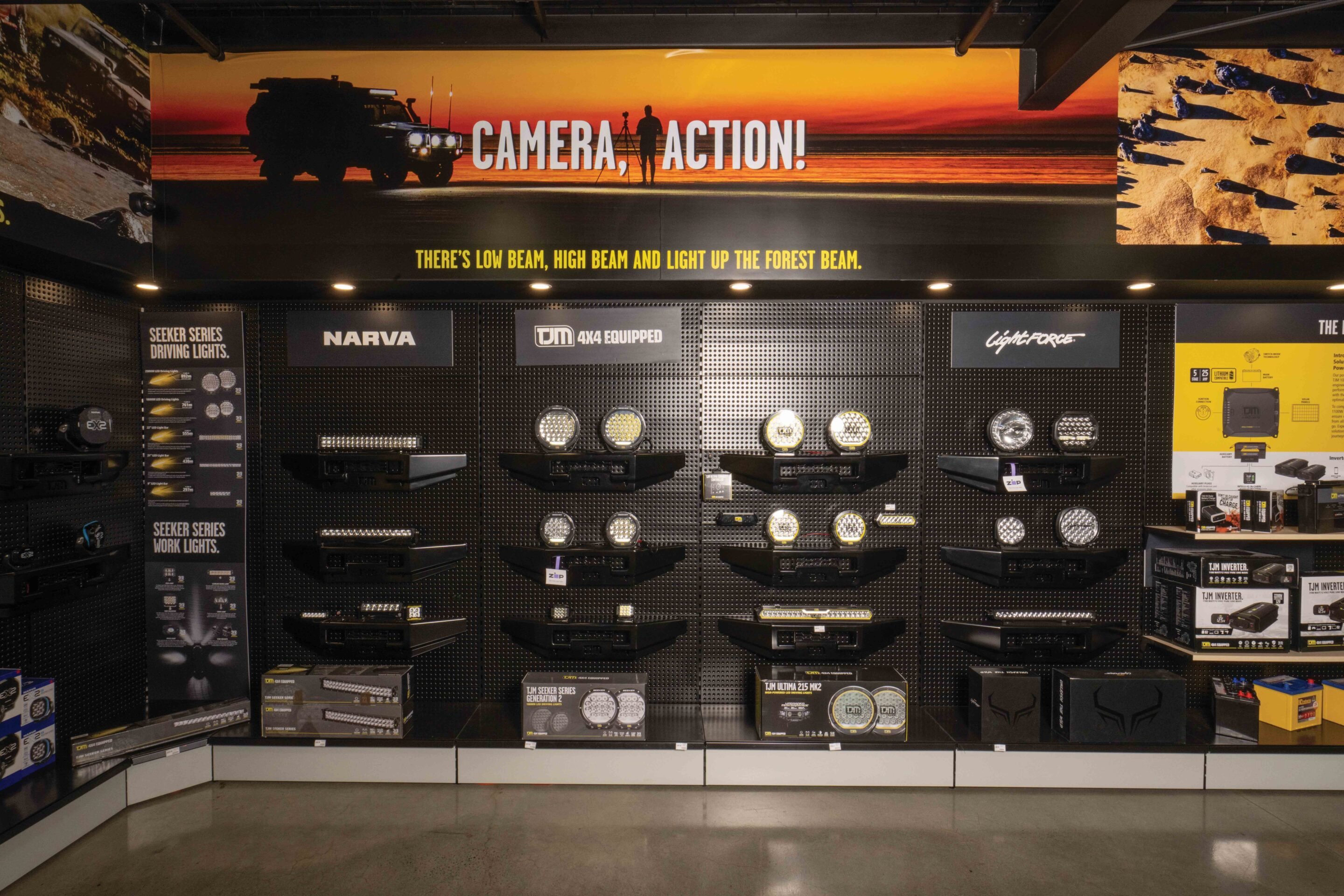
Locally, Aeroklas has invested over $34 million in state-of-the-art distribution centres in Victoria, Queensland and Western Australia, providing more than 25,000m² of warehousing capacity. This ensures distributors receive the latest TJM products quickly, keeping customers equipped for any off-road adventure.
Key benefits of becoming a TJM distributor
Access a $2.15B market
TJM serves Australia’s growing commercial and SUV upgrade sector. With 86 locations nationwide and plans to expand to over 90 by 2025, the network offers significant market potential.
Premium product range
Distributors gain access to TJM’s full suite of products alongside trusted brands including Aeroklas, Flexiglass, Bocar, XGS, and Airtec snorkels. The Preferred Supplier Program allows sourcing of complementary products to meet regional market needs.
National marketing and support
TJM provides national advertising, digital marketing that generated over 4,500 leads last year, professional toolkits, and local marketing support. Collaborative campaigns, store event support, and fleet sales opportunities help distributors grow efficiently.
Engineering and product consultation
Brisbane-based engineers provide consultation to meet specialised customer requests, enabling distributors to tackle complex fitment challenges with confidence.
Advanced supply chain
Distribution centres in Victoria, Queensland, and Western Australia, equipped with advanced logistics systems, ensure fast nationwide delivery to retail, wholesale, and OEM customers.
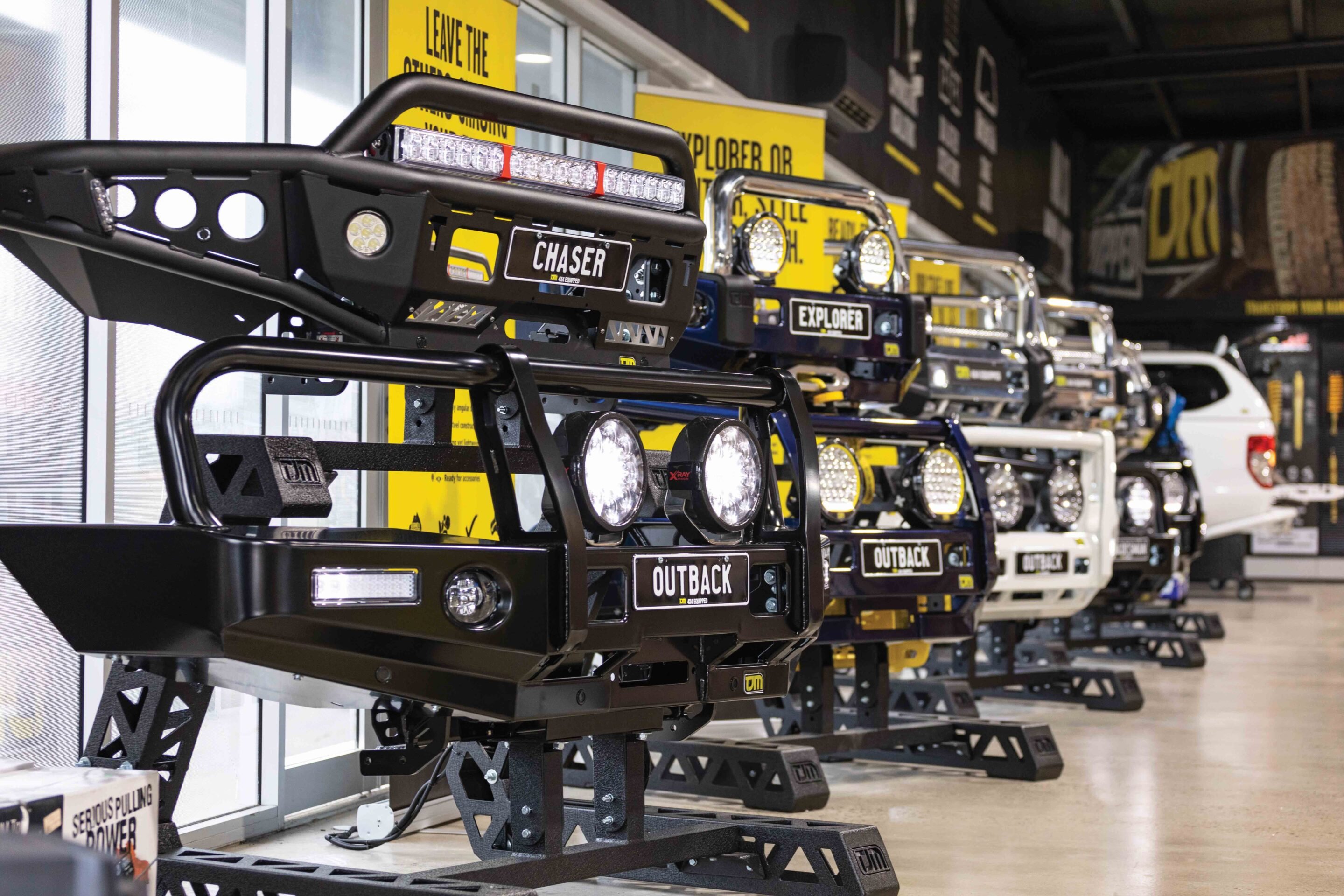
Steps to become a distributor
- Review market opportunities and request guidance from a Business Development Manager.
- Submit an online expression of interest.
- Meet with a local Business Development Manager to discuss opportunities.
- Undergo initial due diligence to assess business suitability and potential store location.
- Submit a Distributor Application Form, business plan, and financial information. No upfront application fee is required.
- Financial due diligence evaluates long-term business capability.
- Receive final approvals, including a Distributor Agreement and store development guidance.
- Complete in-store training and receive on-site support during store launch.
Financial commitment
Launching a TJM store requires capital investment to meet showroom and workshop standards.
Key costs include premises leasing, staff, branded signage, lighting and flooring, sales counter and POS systems, inventory, specialised workshop tools, and a TJM-branded 4WD vehicle. Existing businesses should budget approximately $400,000 to $600,000 to complete fit-out, initial stock, and branded vehicle acquisition.
Opportunity for NSW businesses
Becoming a TJM distributor provides access to a leading 4×4 and outdoor brand, national marketing support, premium product lines, and a proven operational system. Distributors can establish a strong local presence while benefiting from TJM’s national network and industry expertise.
Enquiries are invited from qualified NSW businesses ready to join the TJM network.
MG Motors Australia has confirmed pricing and specs for its all-new MGU9, with three grades on offer: Explore, Explore X and Explore Pro. Prices will sit between $55,000 and $65,000, and pre-orders are already open.
“With the MGU9 range, we’ve created a vehicle line-up that combines comfort, capability and innovation in equal measure,” said MG Motor Business Director, Kevin Gannon.
“Each variant has been designed to deliver a versatile driving experience, whether it’s for daily commercial use, family weekends, or tackling adventures off the beaten track. From refined ride comfort and advanced safety features, to smart design touches that make life easier, the MGU9 proves that Australians no longer have to choose between practicality and innovation when looking for their next ute,” added Gannon.
The ute’s cabin has been built with this usability in mind. A MultiFold seating system allows the second-row seats to fold completely flat, creating a pass-through into the tub when paired with the Smart Hatch. Available exclusively with the top-spec Explore Pro, the Smart Hatch is essentially a retractable rear window that allows direct passage between the cabin and tub.
The front passenger seat can also fold back to form a long, flat surface – a practical feature for rest stops or extra gear storage. Trim is finished in vegan leather, while an aircraft-style gear selector and simplified dash layout round out the driver-focused touches.
Storage has been given equal attention, with 32 different solutions built in. These include a sliding centre console compartment and hidden cup holders, designed to keep the cabin organised and adaptable for work or travel.
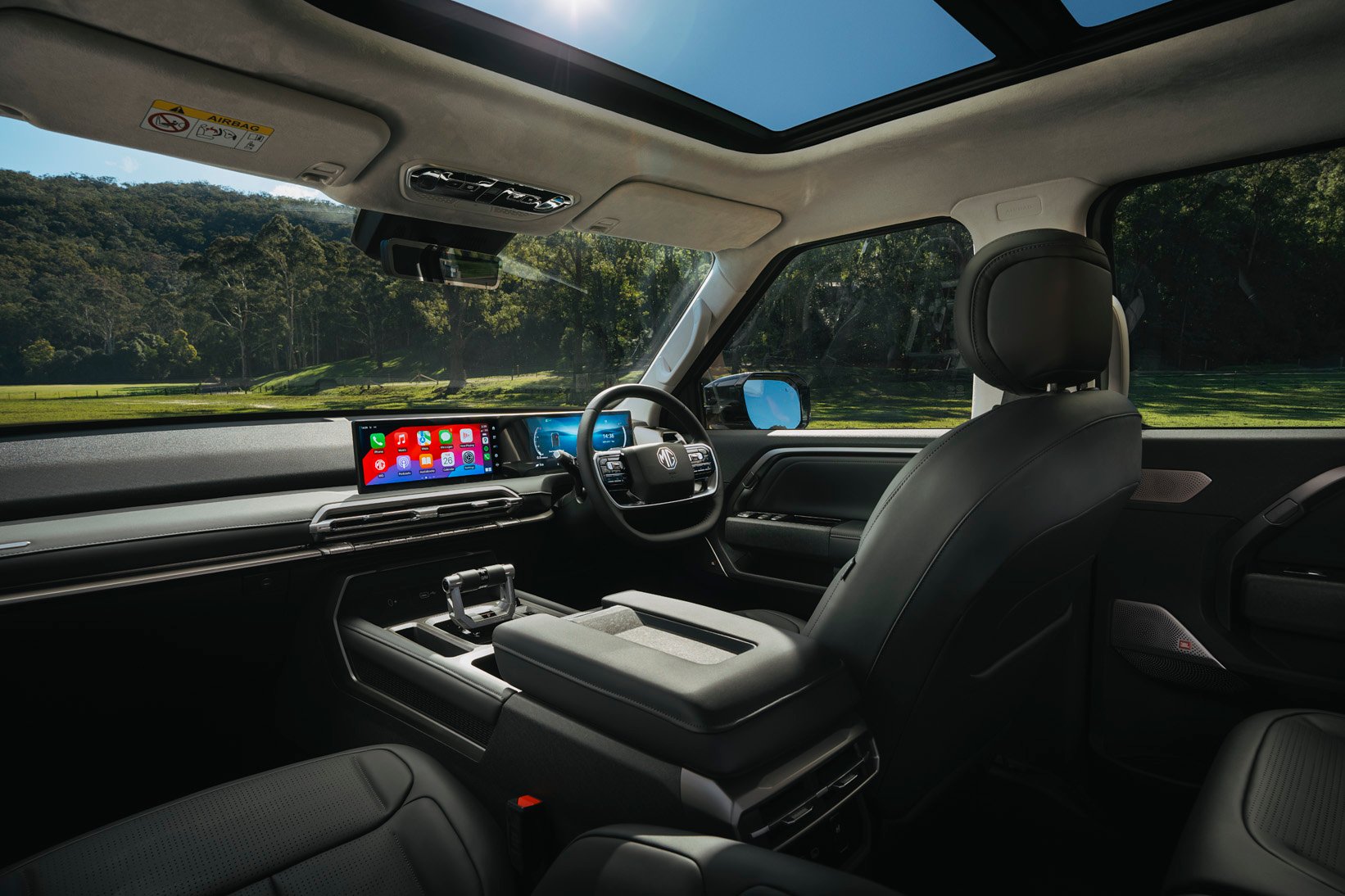
Information previously revealed confirms the MGU9 will combine a robust chassis with multi-link rear suspension, developed and tuned locally for Australian conditions. Towing capacity is rated at 3.5 tonnes, while a foldable rear step adds day-to-day practicality. Power comes from a 2.5-litre four-cylinder turbo-diesel producing 160kW and 520Nm, matched to an eight-speed automatic and full-time all-wheel drive.
The ute measures 5500mm long, 1997mm wide and 1860mm tall, with a 3300mm wheelbase, 220mm of ground clearance and wheel sizes from 18 to 20 inches.
Can one camper really do it all: Quick overnighters, long outback tours, and still feel like home?
Built in South Australia, the Offline Domino proves it can. Aussie-made, bush-ready, and cleverly designed, it’s a hard-floor hybrid that balances toughness with comfort. Could this be Australia’s ultimate all-rounder?
JUMP AHEADnavara
- Who is Offline Campers?
- What is the Offline Domino?
- Construction and build quality
- Setup options
- Power and water systems
- Rivals and comparisons
- Other models in the range
- Target buyers
- Towing performance
- Test route
- Warranty and support
- Pricing
- Weights and measurements
- External specs
- Kitchen and appliances
- Verdict
Who is Offline Campers?
Offline Campers is the passion project of Sam Reynolds, an engineer who can’t sit still.
He knocked up three campers in his shed, realised he was onto something, and now he’s building about 50 a year out of the old Holden plant in Elizabeth. The plan is to push that to 100-150, but the pace is Sam’s call – he’d rather get it right than churn them out.
When he’s not at the factory, he’s usually somewhere remote on two wheels. Sam’s the type who thinks a good time is crossing the Simpson, and he’s gearing up to do the Madigan Line with nine bikes and nine campers in tow. He rolls a J-MAX–modified 300 Series with a 4100kg GVM and has no patience for half-baked gear. Offline sells direct only, no dealers, because Sam wants you dealing with the people who actually build the thing.
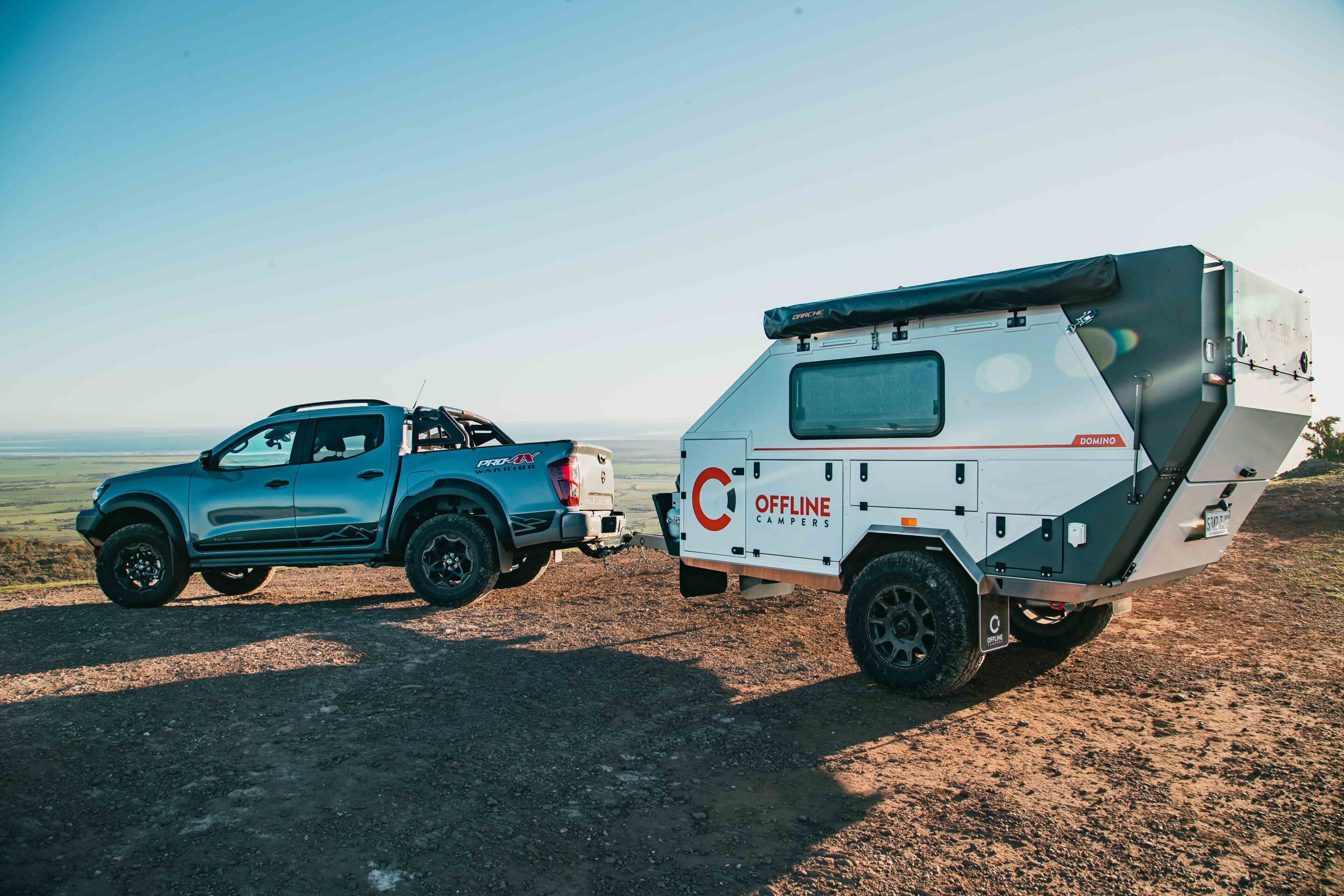
What is the Offline Domino?
If the Track Tvan is the old benchmark for serious, Australian-made hard-floor campers, the Domino feels like the next evolution.
It takes the same DNA – compact footprint, go-anywhere stance, set up in minutes – and pushes it further with a smarter rear-door design, significantly more headroom, a contemporary build methodology, and Sam Reynolds’ trademark ethos of “only the best components will do.” That’s why the Domino doesn’t just compete, it sets the pace.
Physically, it’s a tidy, well-proportioned package. At 5100mm long, 1800mm wide, and 2350mm high, it’s no broader than a Ford Ranger or Navara Warrior, which means it follows your tow rig easily through tracks and backroads. With a tare of 1300kg and ATM of 1900kg, you’ve got 600kg of payload and a 150kg ball weight – friendly numbers for mid-size 4WDs and capable SUVs, not just big wagons and dual-cabs.
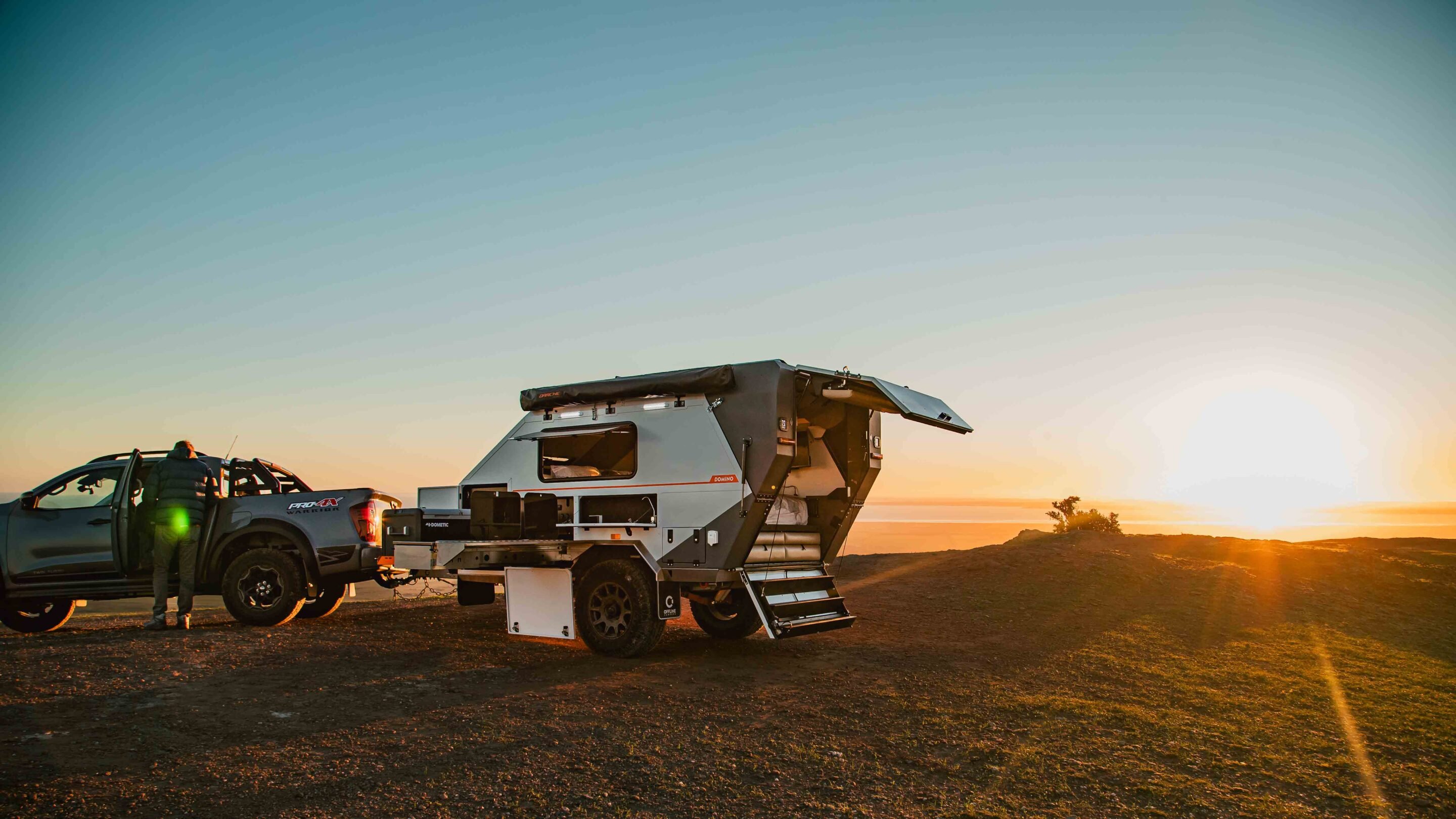
Outside, the layout is classic Offline: tough, practical, and a little bit clever. The slide-out stainless kitchen features a three-burner Dometic stove that’s permanently plumbed into the camper. Thanks to an in-house designed cut-off valve, it’s fully compliant and much easier to use than the old bayonet setups. There’s a huge slab of prep bench space, while a GPO in a side locker is perfectly placed for an induction cooktop or coffee machine.
The filter tap brings clean drinking water straight to hand. On the far side, a 23Zero shower tent drops for a Porta Pottie or a rinse off using the diesel hot water. Up front, a 400-litre locker swallows a Weber Q, a pair of Jerry holders, twin 4kg gas bottles mounts and there is a firewood rack riding on top. The coupling is a DO35 – still the benchmark – which takes care of hooking up.
Cooling is handled by a 95L Dometic CFX on a heavy-duty slide. Inside, 1310mm-long drawers (615mm wide) have been mysteriously designed to neatly fit slabs of beer. Buyers get a Forty Winks credit to pick their own mattress, delivered and installed at the factory. Options include a motorbike rack on the A-frame with a chassis extension, which lifts the ATM to 2500kg. And if you just want the uprated ATM without the bike rack – that’s on the menu too.
Pricing starts at $96,800, moves to around $105,000 as tested, and with every box ticked, you’re nudging $120,000. It’s not cheap, but the Domino feels like one of the smartest, most capable campers on the market today.
Construction and build quality
The Domino’s build is all about strength where it matters and efficiency where it counts.
At its core is a monocoque frame made from 5052 aluminium. It’s a welded box-section and sheet-alloy structure, designed to resist flex without piling on weight. The lower third of the body is skinned in alloy and painted before coated with Raptor coating for protection, while the upper two-thirds use 29mm insulated composite panels inset into the frame. This reduces weight, boosts insulation, and gives the Domino its clean, modern finish.
Behind that alloy skin is a layer of XPS foam, adding insulation. The result is a body that’s cooler in summer, warmer in winter, and far tougher than the plywood or thin-sheet builds still common in some campers. Canvas is all Aussie-made Dynaproof, built to handle years of sun, rain, and red dust.
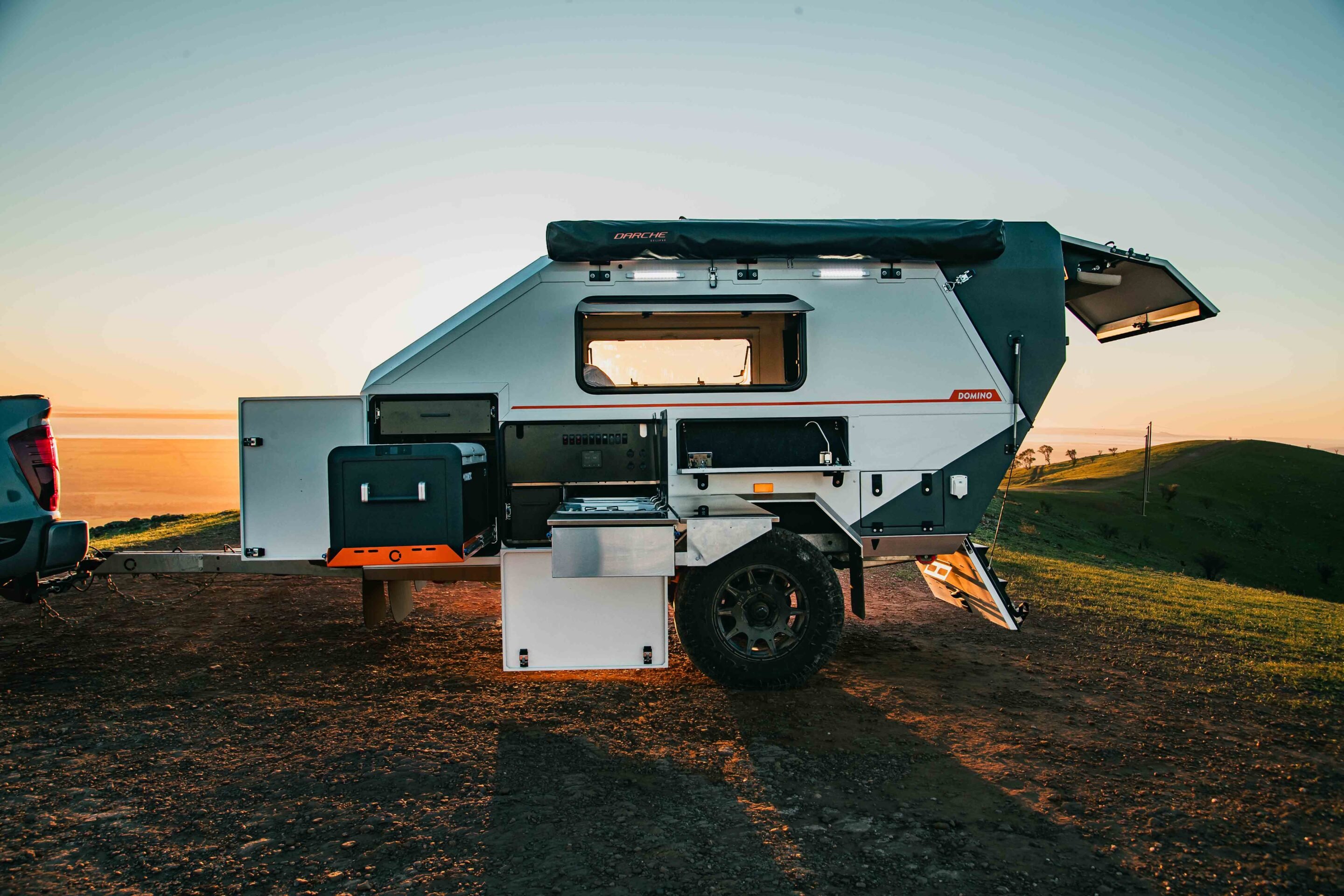
Underneath, the chassis is 100 x 50 x 3mm high-grade Australian RHS steel, laser-cut, jig-welded, and then hot-dip galvanised locally. It’s the kind of foundation that will outlast multiple tow vehicles. Suspension is the proven Cruisemaster XT trailing arm setup, fitted here with Level-3 airbags and twin shocks. A holding tank and Nitto fitting are plumbed in so you can use the same system to reinflate your tyres after a beach run or rough track.
Wheel matching is also smart. You can order the Domino with PCD and offset to match your tow rig, which means you can share spares between the two. The suspension geometry adapts to maintain the Domino’s own track width, so while it may not mirror your vehicle exactly, you’ll always have interchangeable rubber on hand.
It’s a build that balances clever design with sheer toughness – made to survive the outback and keep you comfortable while it does.
Set-up options
One of the Domino’s best features is that it gives you two very different ways to set up: Travel Mode for quick stops, and Camp Mode when you’re settling in.
Travel Mode is all about speed. We used it up on the top of Six Poles – exposed, windy, and not the kind of place you’d plan to stay the night. The process is simple: level the camper with the airbags, open the rear hatch, which is gas-strut assisted, and climb straight into bed. That’s it. No fuss. The whole thing takes just a couple of minutes, which makes it perfect for impromptu overnighters or when you’ve pushed on later than planned and just want to crash.
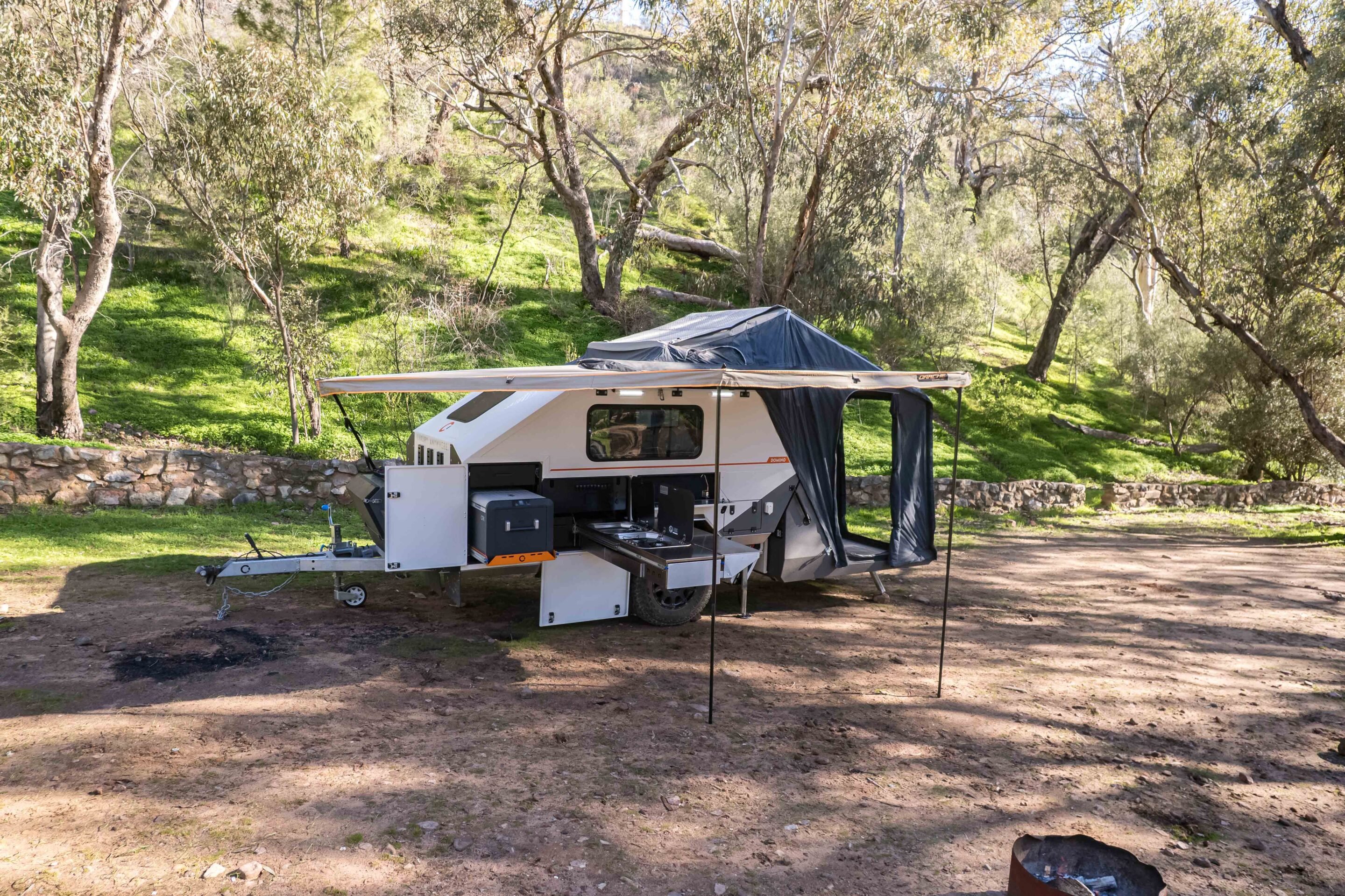
Camp Mode is where the Domino shows off its full personality. We set up in Melrose, SA with room to spread out, a campfire on the go, and time to relax. This setup is a little more involved: unlatch the rear hatch and roof, let the electric actuators lift the tent into place while lowering the rear floor, then tension the tent with a few spreader bars inside. Swing out the 180-degree Darche awning, slide out the full kitchen, and you’re done.
At a steady pace it takes about ten minutes, but the payoff is worth it. You end up with a hard-floor living space that will accommodate a cosy six or a very comfortable four – perfect for a game of cards or just hiding from the elements.
The beauty of the Domino is how seamlessly it switches between these two personalities. Travel Mode keeps you moving, letting you stop almost anywhere with minimal effort. Camp Mode transforms the trailer into a genuine base, built for days at a time. That flexibility is what makes the Domino so well-suited to Aussie outback touring – it adapts to how you travel, not the other way around.
Power and water systems
The Domino is built for serious time off-grid, and power is the starting point.
Most buyers go for the 200Ah lithium battery, which is what our test camper had – it’s the sweet spot between capacity and weight. A 100Ah pack is standard, and if you’re planning really long stays or want to run heavy-draw appliances, you can option up to 400Ah.
Charging is handled by a REDARC BCDC, backed by an Enerdrive AC charger for mains power, and an optional 2600W inverter (with a 3000W option) that lets you run induction cooking, coffee machines, or laptops without stress. A Victron Smart MPPT solar regulator and a Simarine panel keep track of what’s going in and out, so you always know where you stand.
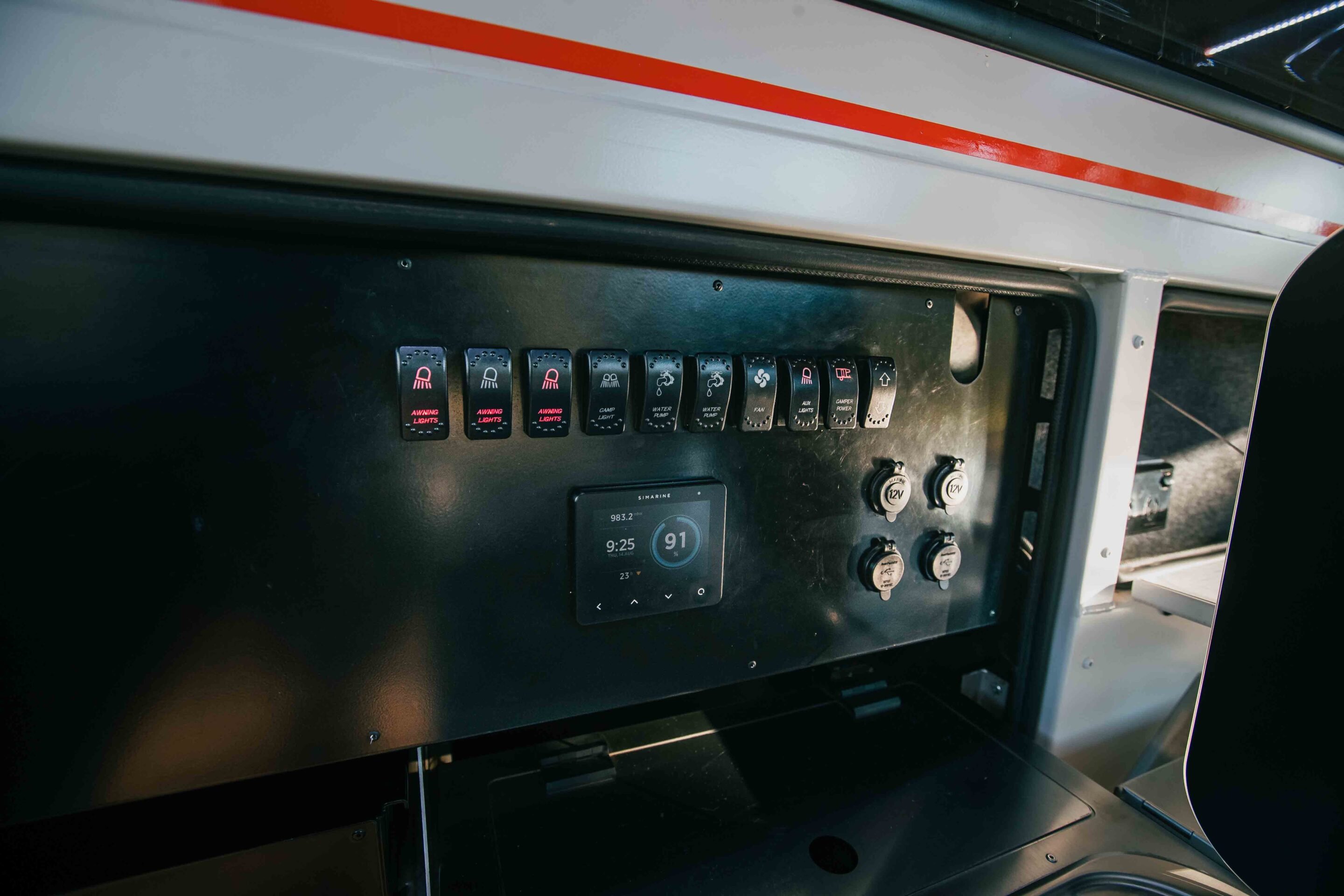
The solar setup on our test Domino was one of its cleverest tricks – though it’s worth noting, all solar is optional. This rig carried an 89W panel that stays exposed in Travel Mode, sipping in charge while driving or parked. A 175W panel sits on the roof lid, feeding in power on the move. Flip into Camp Mode and the lid reveals a second 175W panel on the canvas roof, bringing the total to 439W on our test unit, with ~280W usable in any Mode. There’s also a dedicated input for a blanket panel – add a 400W portable and you’ve got serious capacity, more than enough to keep the fridge humming and the inverter running for the long haul.
Water is no weak point either. The Domino carries 75L of filtered drinking water and 105L in a general-purpose tank. Thanks to a lift pump and filtration, you can refill from stations or creeks and feed straight into the GP tank. Hot water and space heating come from a diesel Webasto, so you’re not chewing through gas bottles.
In practice, a 200Ah setup will keep the 95L Dometic CFX fridge and LED lighting going for 4–5 days with no charge back in. Add solar, and you’re out indefinitely. If you’re leaning on the inverter for induction cooking, expect closer to 2–3 days before you need a top-up – exactly where a portable panel earns its keep. This being an outback camper, the bush toilet is endless, so food and beer will run out before the power or water does.
Rivals and comparisons
The Domino doesn’t exist in a vacuum. Three of the most obvious rivals are the Track Tvan T3, Patriot X3, and Ultimate Nexus – all serious Australian-made campers with their own quirks.
Pricing puts the Domino right in the thick of it. The Tvan T3 starts around the $90–100K mark depending on spec. The Patriot X3 sits a little lower at around $86–90K, while the Ultimate Nexus comes in from roughly $76K (before options and the Nexus needs a few). The Domino, at $96K base and around $105K as tested, is priced to slot neatly among them – more expensive than the Nexus, about even with the Patriot, and a touch under the Tvan once you start matching features.
The Tvan T3 is the Domino’s closest rival in concept: a hard-floor camper built tough for the bush. Its alloy construction makes it rugged, but it feels noticeably cramped around the bed head compared to the Domino, and it carries a little more bulk. Where it shines is full setup: like the Domino’s Camp Mode, it’s designed to be opened to expose a rear hard floor but its fast set-up is not as clean or usable as the Domino’s Travel Mode.
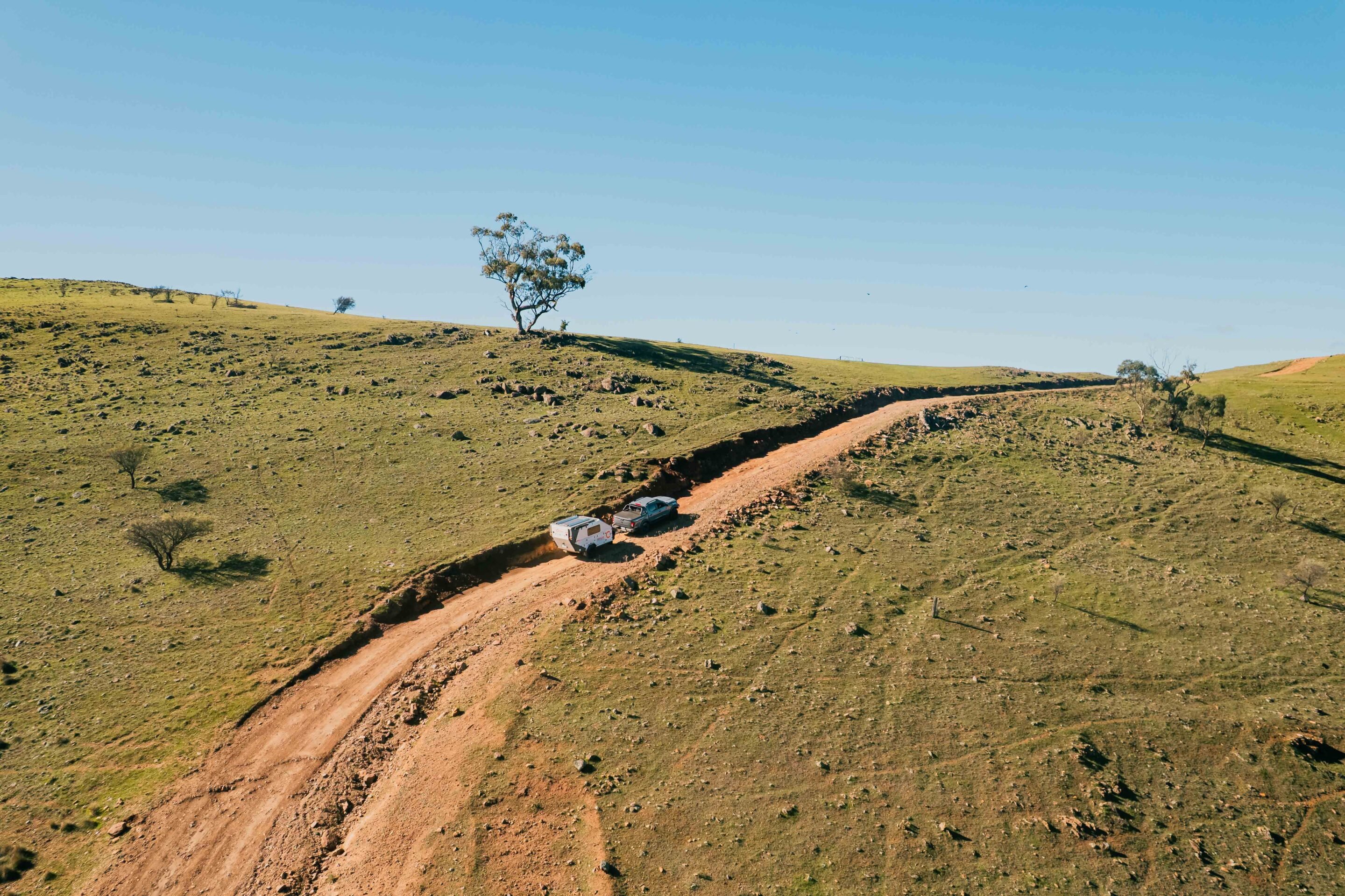
The Patriot X3 plays a different game. It’s light at about 1,160kg tare and compact when packed, but once opened it needs more campsite space thanks to its side-hinged design. Water capacity is healthy at 150L, but the electrical spec feels dated: AGM batteries and a 1,500W inverter don’t stack up against the Domino’s lithium-ready system and larger inverter. Durability is solid, with alloy frame and panels, but interior lounge space is tight compared to the Domino.
The Ultimate Nexus also opens to the side, so like the X3 it demands more campsite real estate than the Domino. At under a tonne tare it’s extremely easy to tow and packs down neatly, but when deployed it spreads wide. Water capacity is good at 160L fresh plus 50L grey, and lithium power is standard, but lounge space is minimal and its fibreglass construction makes it less durable in serious bush work than the alloy-bodied Domino, X3 or T3.
Stacked against these, the Domino offers the best mix of durability, power, water versatility, and interior comfort. In quick-stop mode (Travel Mode) it matches the T3 for speed of set up but sets up cleaner, and in full Camp Mode it outshines all three for total living space and long-stay self-sufficiency.
Other models in the range
While the Domino has become Offline’s headline act, it’s part of a broader family of campers designed around the same principles: strong alloy construction, smart power and water systems, and serious off-road ability.
The Raker is the original. A rear-fold hard-floor with a low towing profile, it offers heaps of internal space once opened. It shares the same core water and power setup as the Domino, so it’s equally capable off-grid, but it’s more traditional in form – a classic rear-fold refined by Offline’s attention to detail.
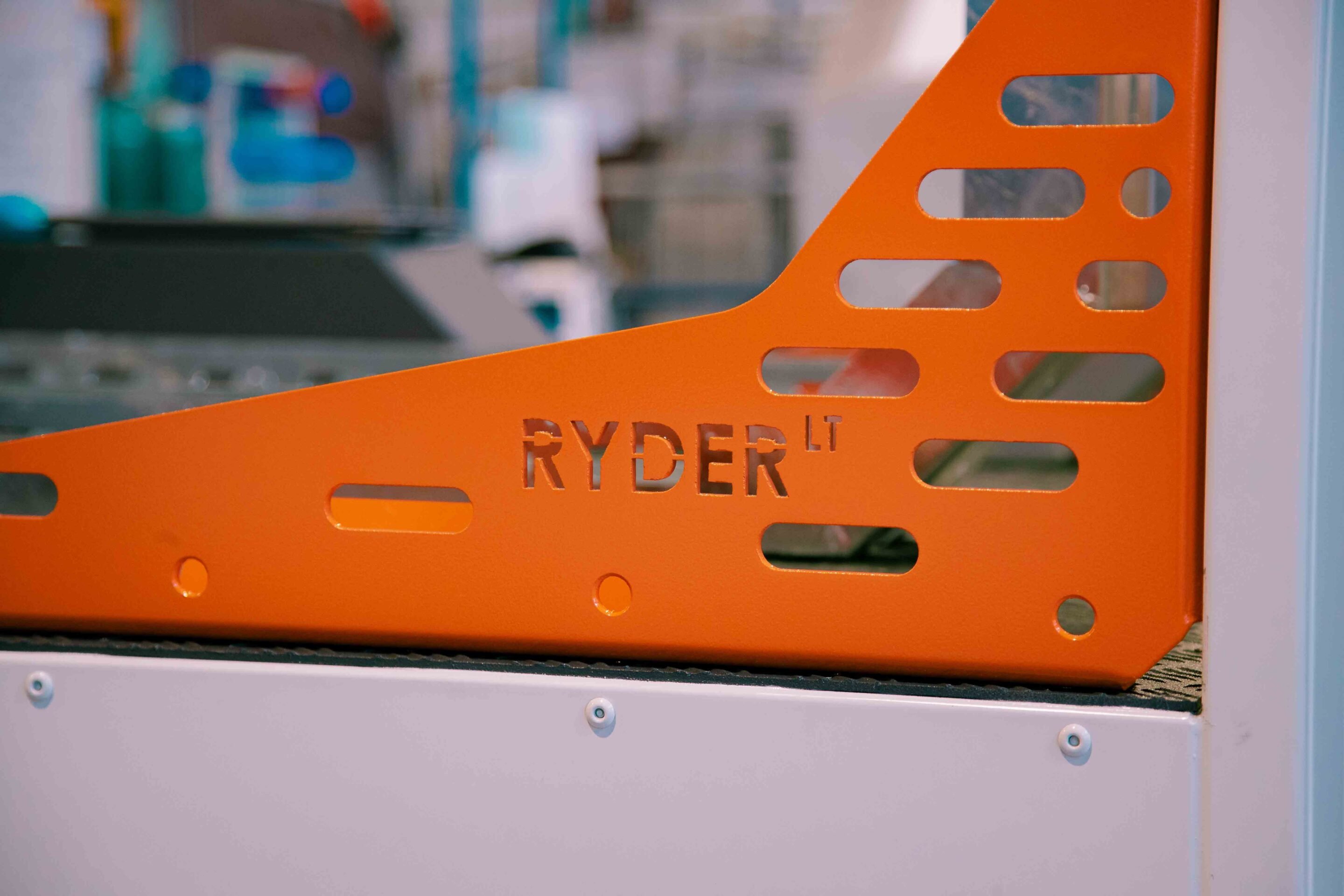
The Solitaire was the company’s first hybrid. Built with a walk-in door and a lifting roof, it’s aimed at buyers who want more of a caravan-style feel without losing the off-road chops. Available in 14- and 16-foot layouts, it adds interior cabinetry and living space, but stays true to Offline’s rugged DNA.
The Ryder is the toy hauler of the range, designed to carry bikes, side-by-sides, or extra adventure gear with an ATM of up to 2500kg (1900kg is standard). It’s the pick for riders and families who don’t want to choose between hauling toys and having a fully featured camper.
Finally, the Ryder-Lite is on the horizon. Think of it as a budget-conscious Ryder: no tent, no full kitchen, but built with all the critical elements intact – the same chassis, deck, optional underslung water tanks, and suspension that make every Offline product capable in the rough. It’s a stripped-back platform for those who have a tent on the tow-rig or plan to swag it but want water and storage.
Target buyers
The typical Domino buyer isn’t someone chasing the cheapest deal.
Offline’s customers are usually people who have built success in their own fields – engineers, architects, business owners – and they recognise good design and execution when they see it. They’re not impressed by gimmicks or cookie-cutter campers; they want something that’s as reliable and capable as they are.
What unites these buyers is a preference for gear that works. They don’t want to be fussing with niggles or patching problems in the middle of nowhere. The Domino appeals because it’s engineered to perform exactly as advertised: a camper that gets you there, keeps you comfortable, and doesn’t quit when the tracks get rough.
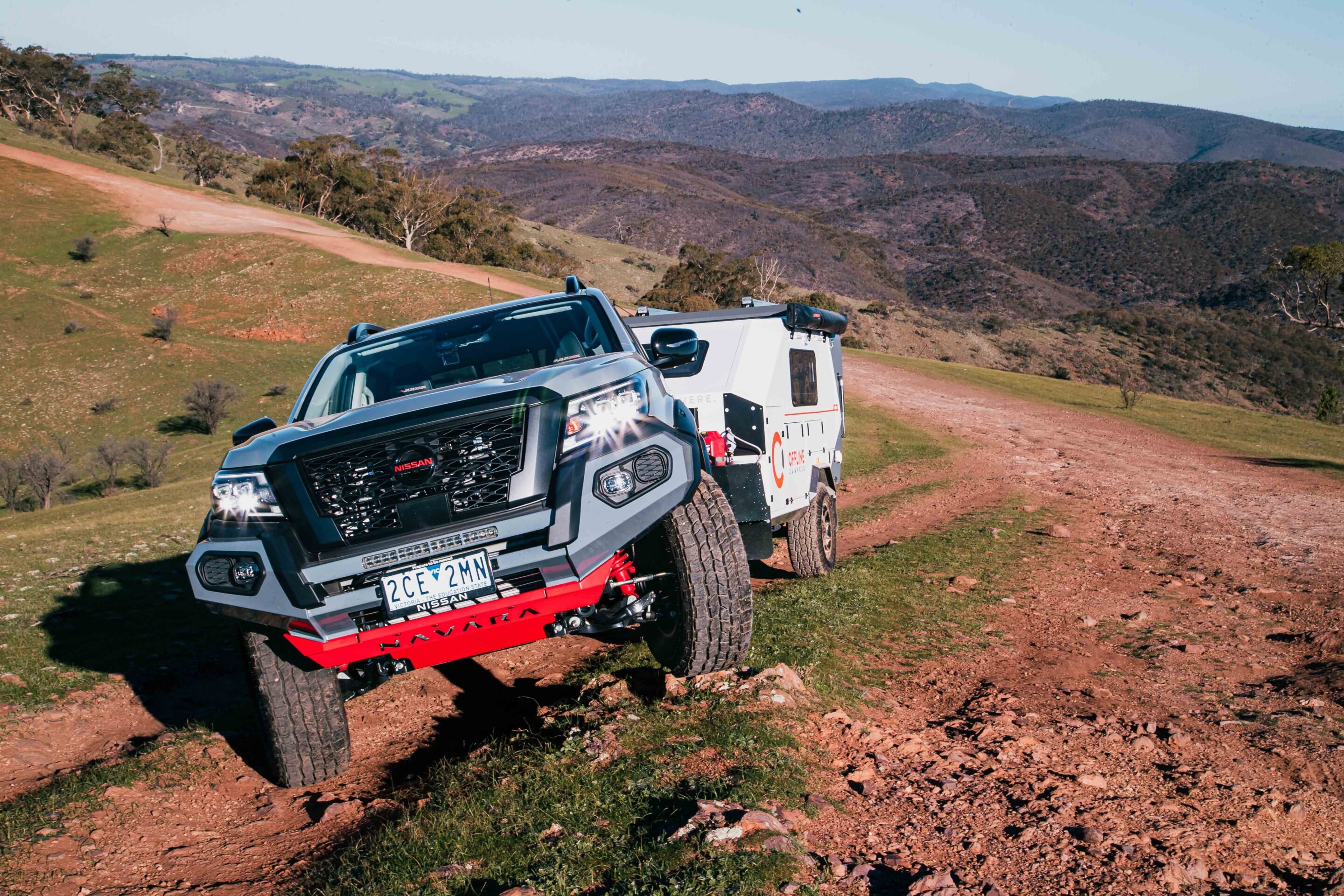
There’s also a strong appeal for those who like to back a local builder with a direct-to-customer model. Knowing they’re dealing with the people who actually design and build the camper – not a dealership sales chain – carries weight with this audience.
In short, the Domino is bought by people who don’t cut corners in their own lives and don’t want to compromise when they travel. It’s a camper for those who value confidence in the bush as much as comfort around the campfire.
Towing performance
On the road, the Domino tows beautifully.
Its narrow 1800mm width means it tucks neatly behind the tow vehicle, with no need for extended mirrors – a rare win in the camper world. Clearance is excellent, and the chamfered rear end makes it easy to drop into creek beds or tackle departure angles that would hang up a boxier van.
We paired it with a Nissan Navara PRO-4X Warrior, and it was a great match – stable, easy to manage on the highway, and surefooted off it. With a shorter overhang tow rig, such as a Prado or other capable SUV, you could explore deeper into tighter country where length is the limiting factor.
The Domino’s standard ATM is 1900kg, but it can be optioned up to 2500kg with the chassis extension and motorbike rack. If you go that heavy, you’ll want a full 3,500kg-rated 4WD to give yourself breathing room on GVM and GCM limits.
Electronic Stability Control isn’t fitted – and frankly isn’t needed. With its low centre of gravity, modest weight, and balanced design, the Domino feels planted and predictable, whether you’re cruising freeways or threading it down back-country tracks.
Test route
Our loop north of Adelaide took in the Bridle Track, a classic outback run that links the ranges with the gulf.
First pushed through in the 1800s to move ore and supplies, it remains one of South Australia’s most rewarding drives. The track is strictly dry-weather only – clay sections turn treacherous when wet – and it passes through working farms, so it’s essential to leave gates as you find them. In return, it offers some of the best views you’ll see over the Spencer Gulf, with sweeping ridgelines and wide open skies. It is a drive worth doing.
We dropped into Six Poles, a windswept high point that makes you feel on top of the world, before continuing west into Melrose. South Australia’s oldest town sits at the base of Mount Remarkable and has become a hub for mountain biking, with trails spilling from the hills straight into the local brewery. It’s an iconic stop on any Flinders Ranges adventure.
Warranty and support
One of Offline’s biggest strengths is that you deal directly with the people who built your camper.
There’s no dealer network to muddy the waters, no middlemen making dodgy calls on repairs. If something goes wrong, Sam and his team handle it themselves, usually responding within 48 hours of a claim being lodged.
The warranty itself is straightforward: two years cover on the camper as a whole, five years on the chassis, and five years on the Cruisemaster suspension. Appliances like fridges, stoves, heaters and the diesel hot water service are covered separately by their original suppliers, and owners are responsible for routine servicing – wheel nuts, bearings, and suspension checks at set intervals. The warranty is transferable if the camper is sold, adding resale value.
Offline’s approach is clear: maintain the camper properly and they’ll stand behind it. For buyers, that direct line to the factory is as reassuring as the warranty itself.
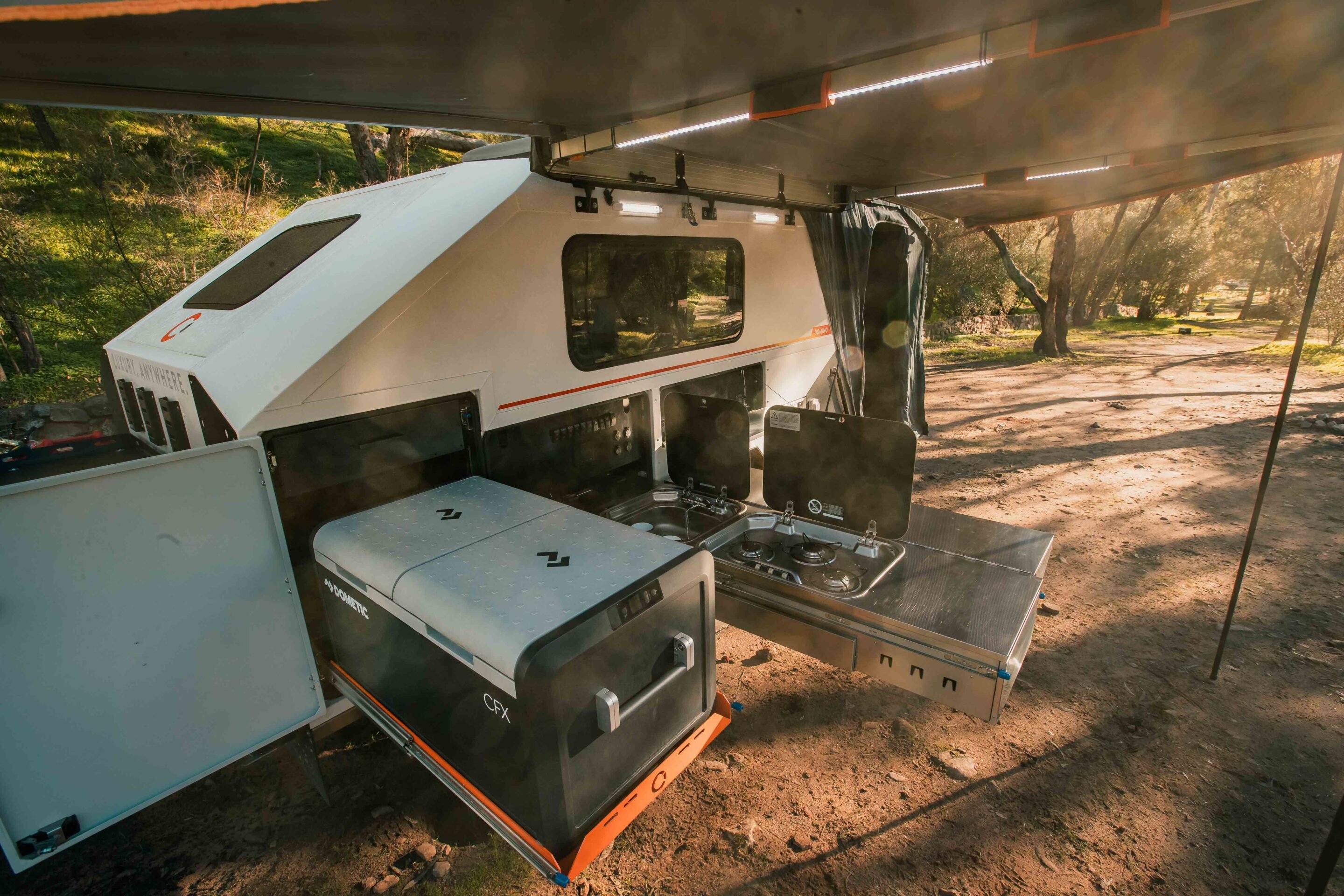
Pricing
- Price from: $96,800
- Options fitted: 200Ah Lithium, 2600W inverter, 489W combined solar
- Price as tested: $105,000
Weights and measurements
| Overall length | 5.1m |
|---|---|
| Width | 1.8m |
| Travel height | 2.35m |
| Tare | 1300kg |
| ATM | 1900kg |
| Payload (calculated) | 600kg |
| Ball weight | ~150kg |
External specs
| Frame | 5052 grade aluminium |
|---|---|
| Cladding | 29mm composite panels |
| Chassis | 100 x 50 x 3mm high-grade Australian RHS steel, hot-dip galvanised |
| Suspension | Cruisemaster Level-3 XT Airbag |
| Coupling type | DO35A |
| Brakes (size/type) | 12-inch electric drum |
| Wheels | PCD and offset matched to tow vehicle, $2000 allowance for wheels and tyres |
| Water | 105L general-purpose tank, 75L filtered drinking tank |
| Battery | 100Ah lithium (standard) |
| Gas | 2 x 4kg bottles |
Kitchen and appliances
| Stove | Three-burner Dometic |
|---|---|
| Fridge | Dometic CFX95 |
| Shower | 23Zero tent with external shower rose |
| Hot water | Webasto diesel system |
Verdict
The Domino feels purpose-built for busy travellers who want to maximise their time away without wasting hours on setup or dealing with fragile gear. Its two personalities – fast, no-fuss Travel Mode and the full-featured Camp Mode – make it adaptable whether you’re pushing on or settling in.
Bush readiness is baked into the design. From the chamfered rear and high clearance to the rugged monocoque alloy body and galvanised steel chassis, the Domino is made for red dust and rocky tracks. It’s equally well thought out when parked: a smart dual water system with optional creek-draw ability, a decent lithium and OK solar package, and practical storage solutions that show real-world testing behind the design.
At 1300kg tare it’s impressively light for what it offers, towable by more than just the biggest rigs, yet it still feels rock-solid on and off-road. Exceptional build quality rounds it out – proof that Offline builds campers to last, not just to sell.
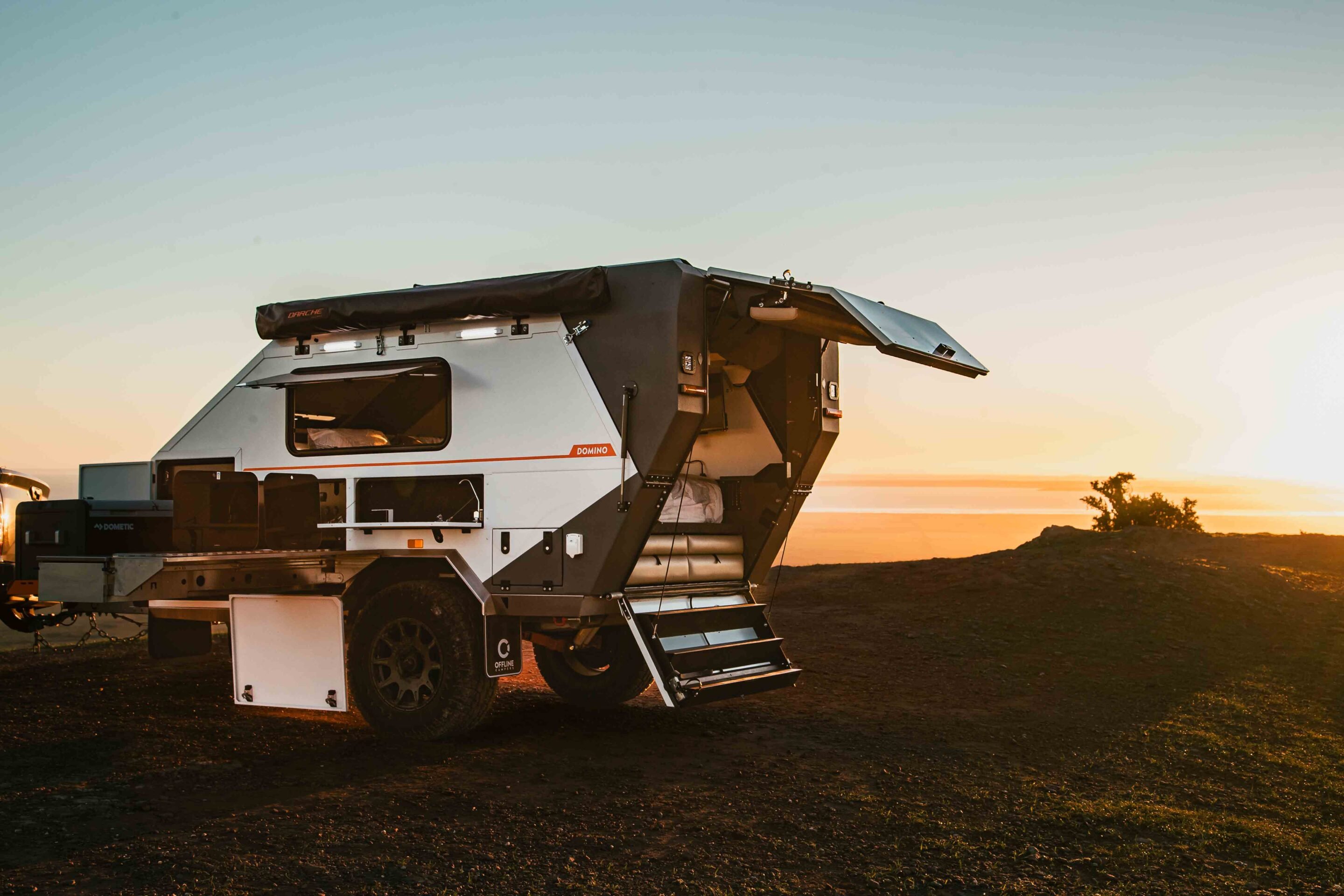
More information: Offline Campers
Tenancy 1A, Main Gate, 180 Philip Hwy, Elizabeth SA 5112
P: 08 7286 9213
E: [email protected]
W: offlinecampers.com.au
A sat phone is often held up as the gold standard of outback preparedness, but is it really enough on its own?
Sure, it can get you out of trouble and possibly even save your life – or at least spare you a few unplanned nights in the desert – but having a sat phone doesn’t automatically mean you’re well-prepared.
Imagine the common scenario: the vehicle catches fire or breaks down, and you’ve got just enough time to grab some gear before it’s unusable. In a makeshift shelter, you might still have a gas stove and bottle, saucepans, thermos and cups, a jerry can of water, a box of supplies, some bedding and a few other assorted goodies. On the surface, it looks like you’re travelling with all the right kit.
But here’s the real question: Is this another example of travelling ‘with all the gear and no idea?’ It’s something we’ve seen plenty of over the years, especially as more people head off on Aussie adventures rather than sticking to the usual highways and tourist routes. And who can blame anyone for wanting to see a bit of their own country?
The problem is, you can’t just buy all the gear and head into the unknown as though it were a trip down the coastal highway to Byron Bay, or an easy run to Wilsons Promontory. The smart travellers join a 4WD club or go on a tag-along tour to learn new skills and techniques – and hopefully a little about being prepared. That way they can enjoy a long-range desert sojourn and, in the process, stay out of trouble.
At the very least, take a basic course in how to drive a 4WD. If you’ve never done it before, don’t be so sure you already know how to handle sand, cross a river or climb a steep hill.
It’s also imperative to learn about the dangers of desert travel, including the risk of fire from the build-up of spinifex under a vehicle, especially around exhausts, DPFs and catalytic converters. Anyone travelling through spinifex country should be checking under the vehicle at regular intervals.
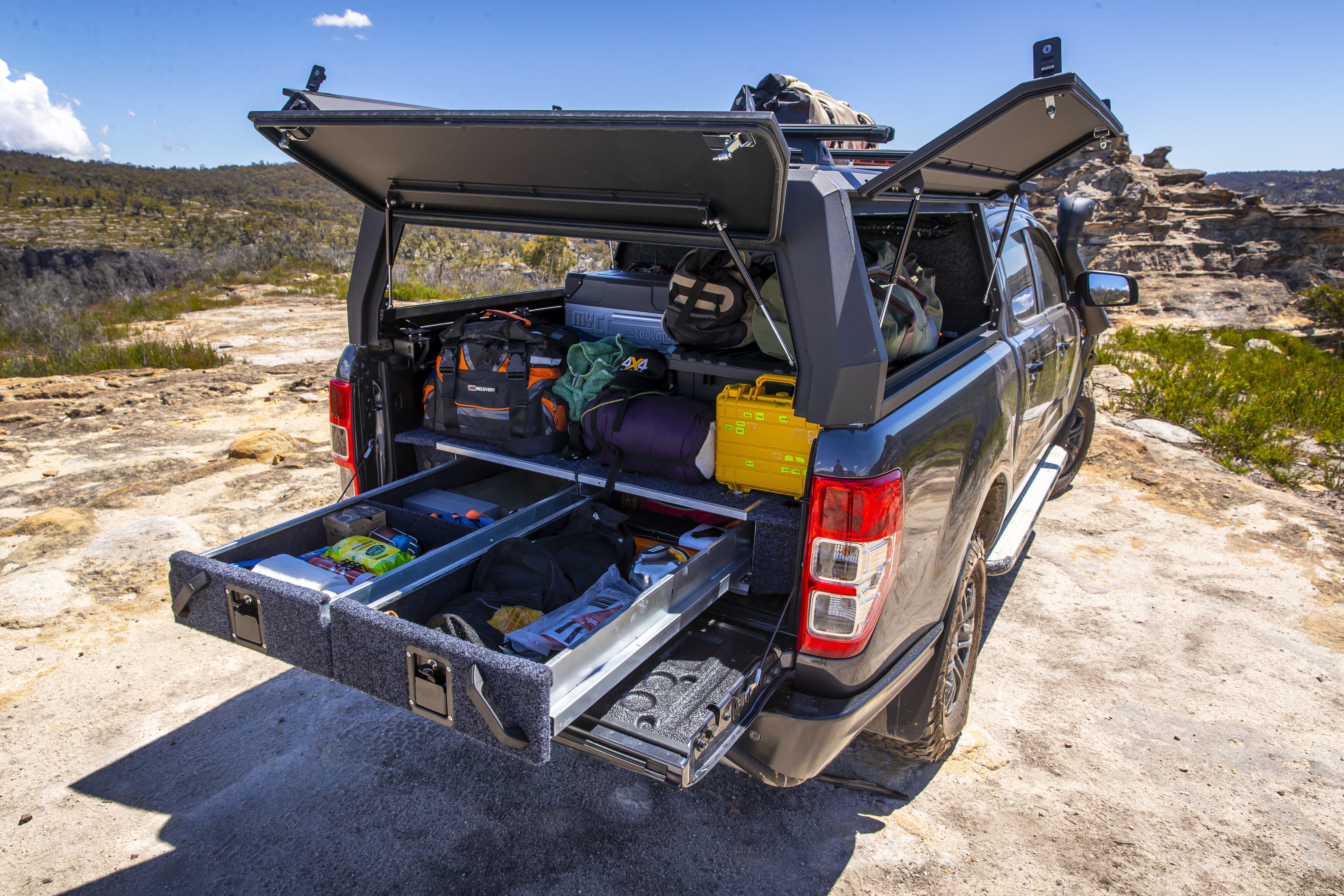
And then there’s equipment. If a fire does break out, do you have an extinguisher on hand – and do you know how to use it quickly? Everyone heading into the scrub should carry at least one as a minimum.
A brand-new car and camper doesn’t make you immune from breakdowns, punctures or even fire. Carrying just a sat phone is not being well-prepared. Yes, it’s a step in the right direction, but real preparation means planning ahead, having a basic knowledge of repairs, carrying the tools for the job, and packing the essentials like a first-aid kit, recovery gear and multiple forms of communication.